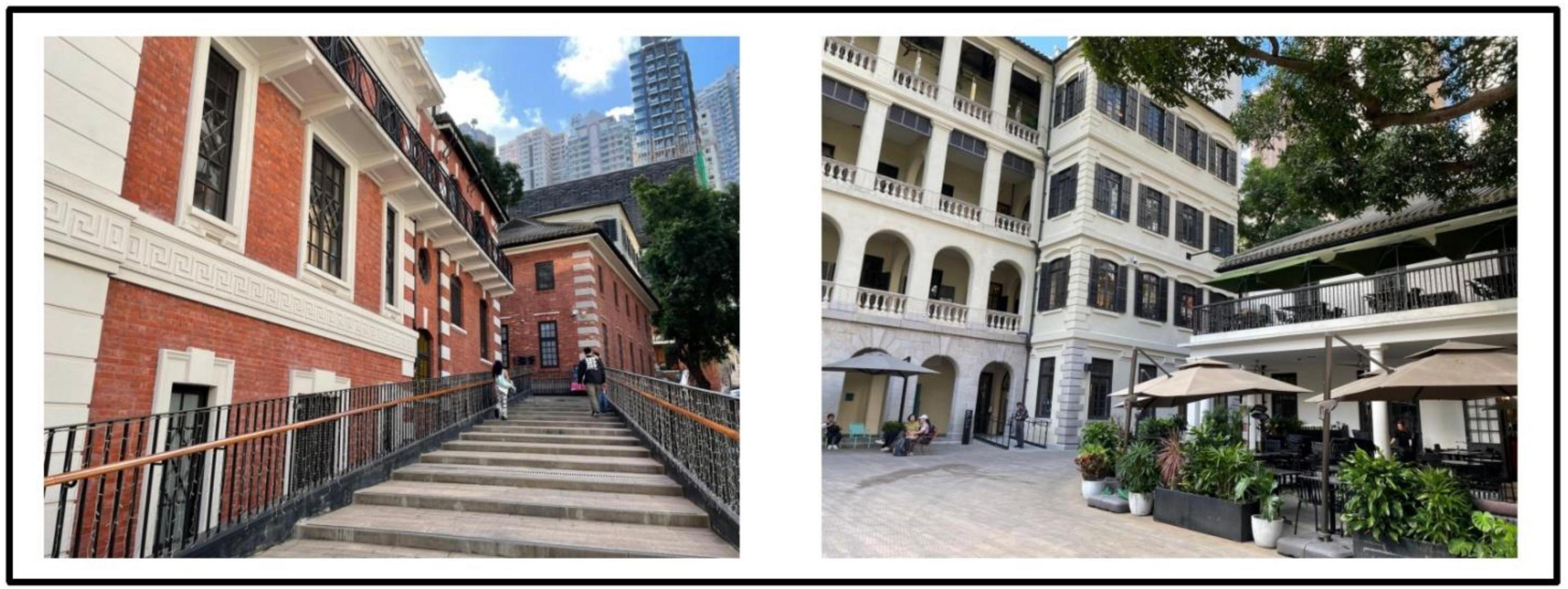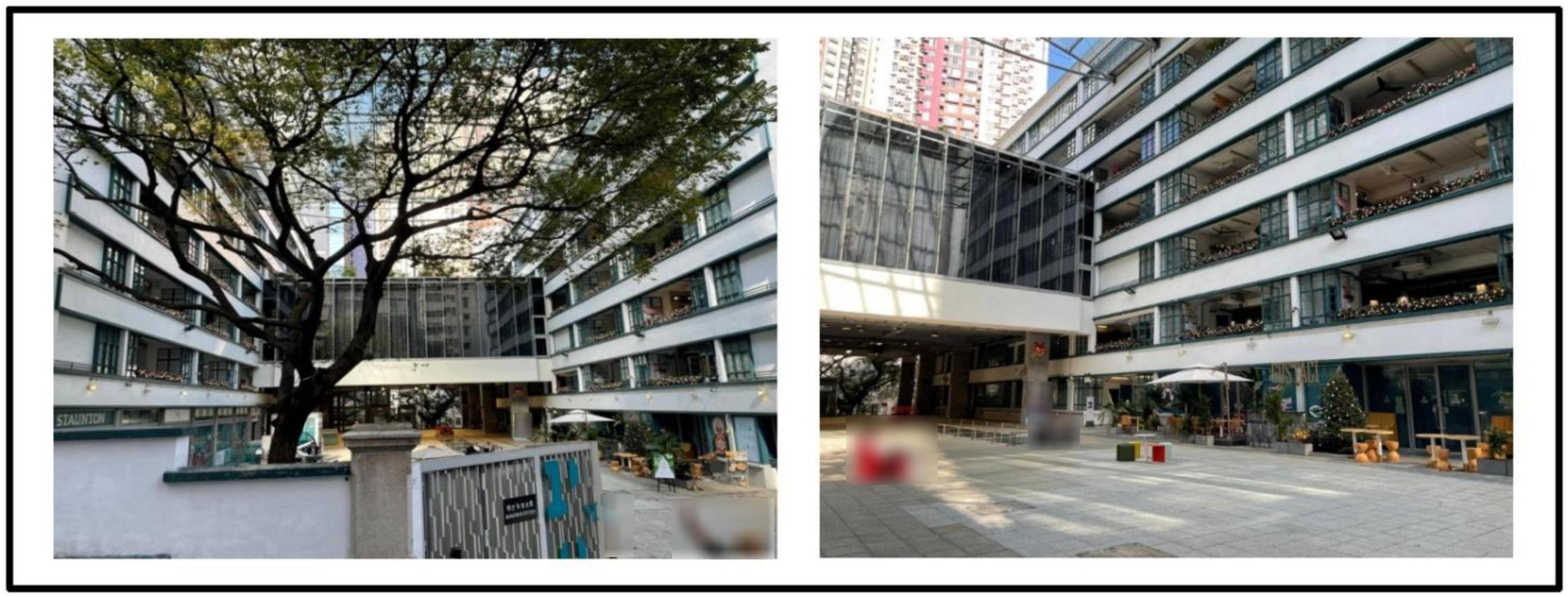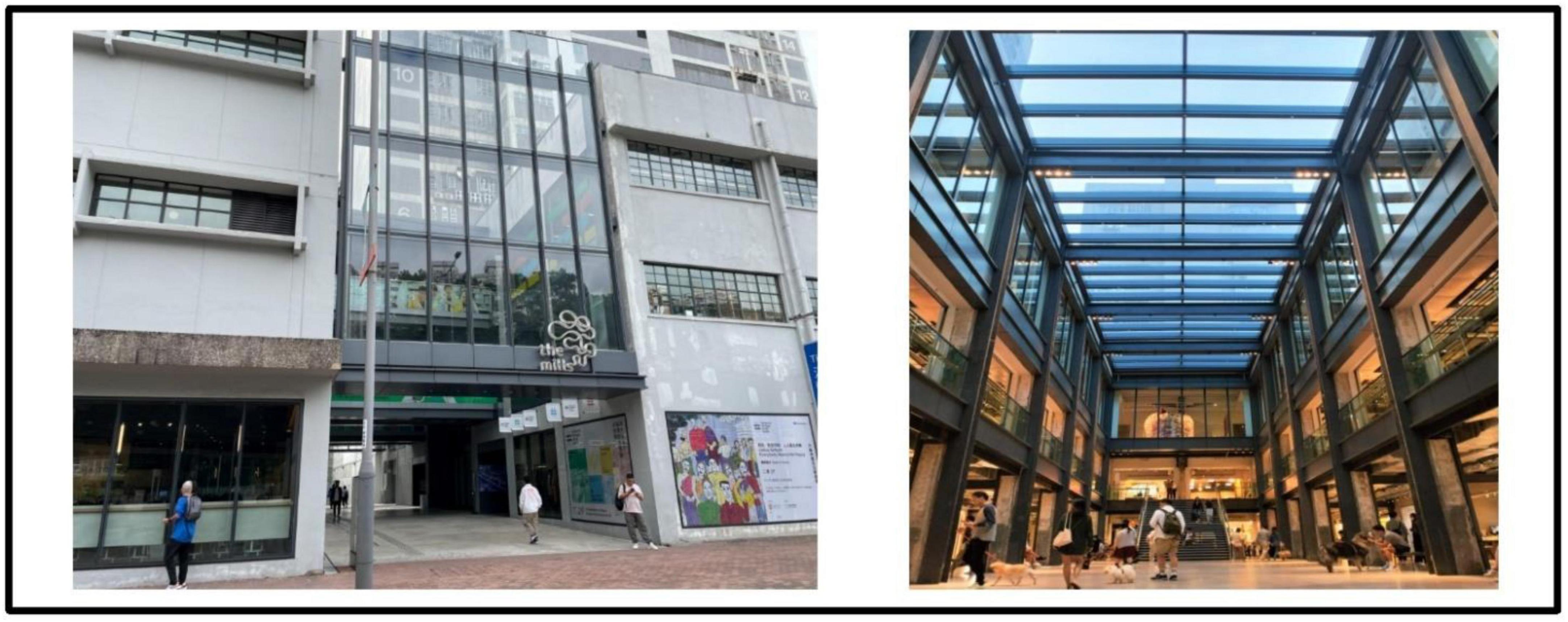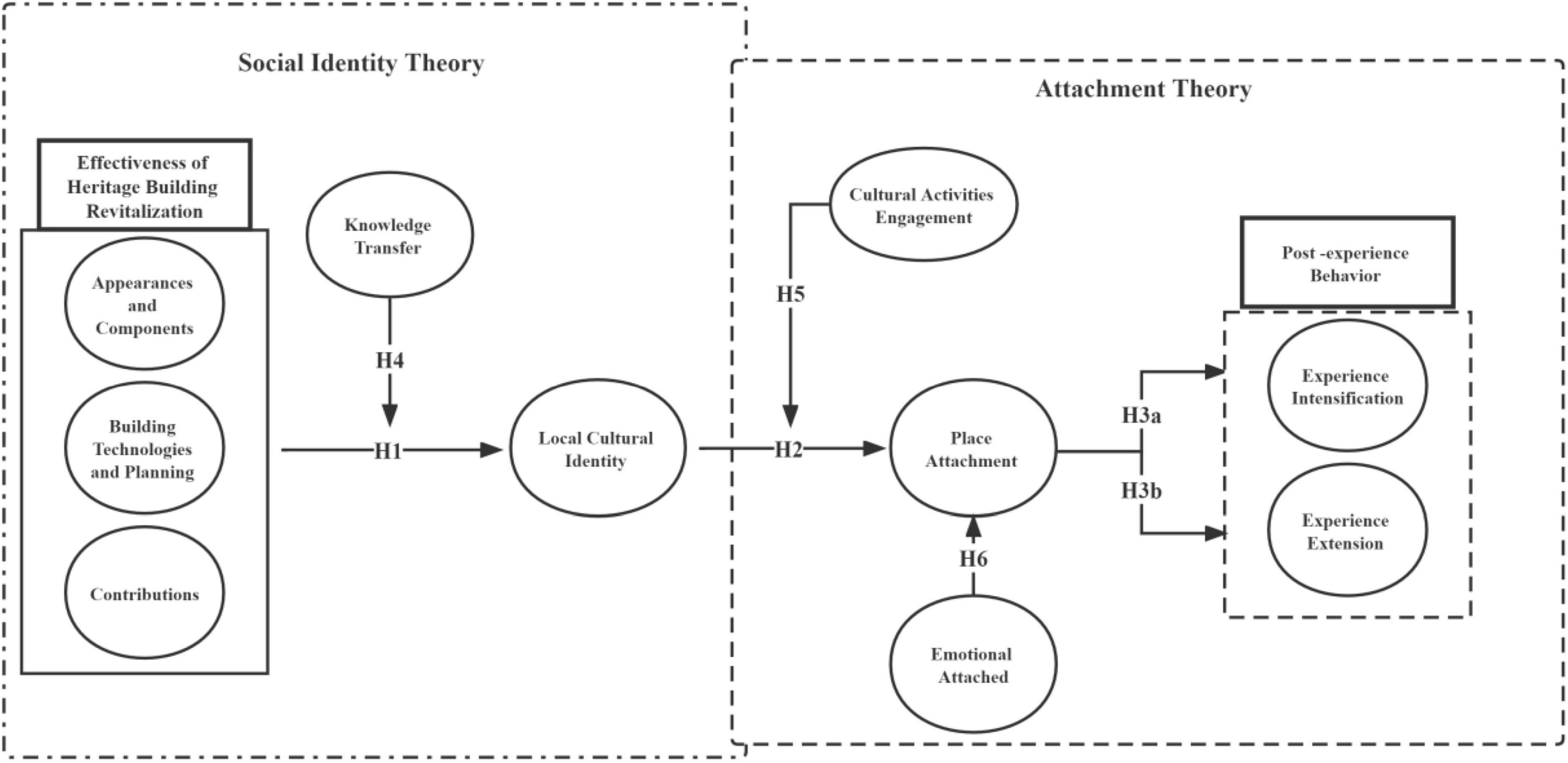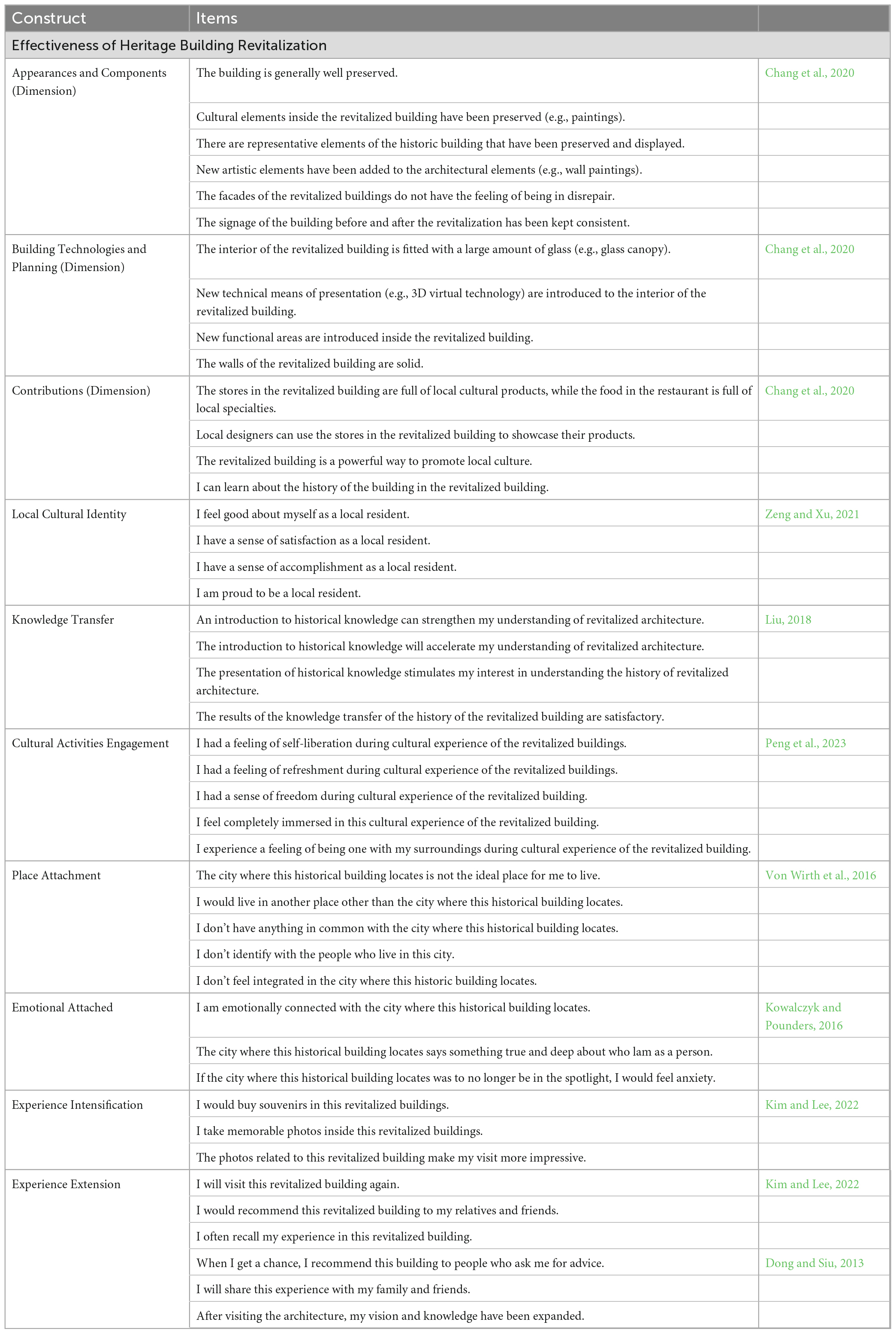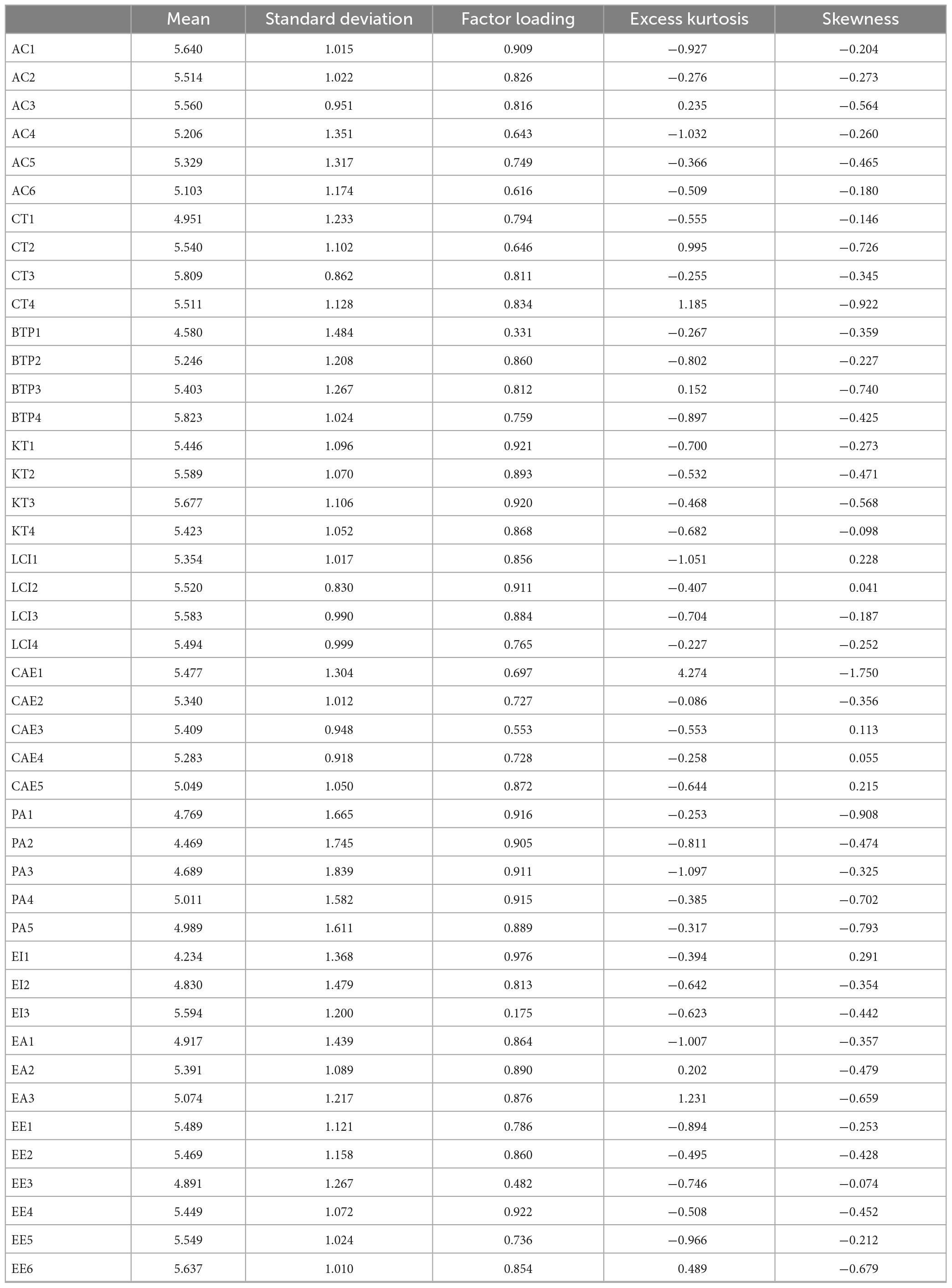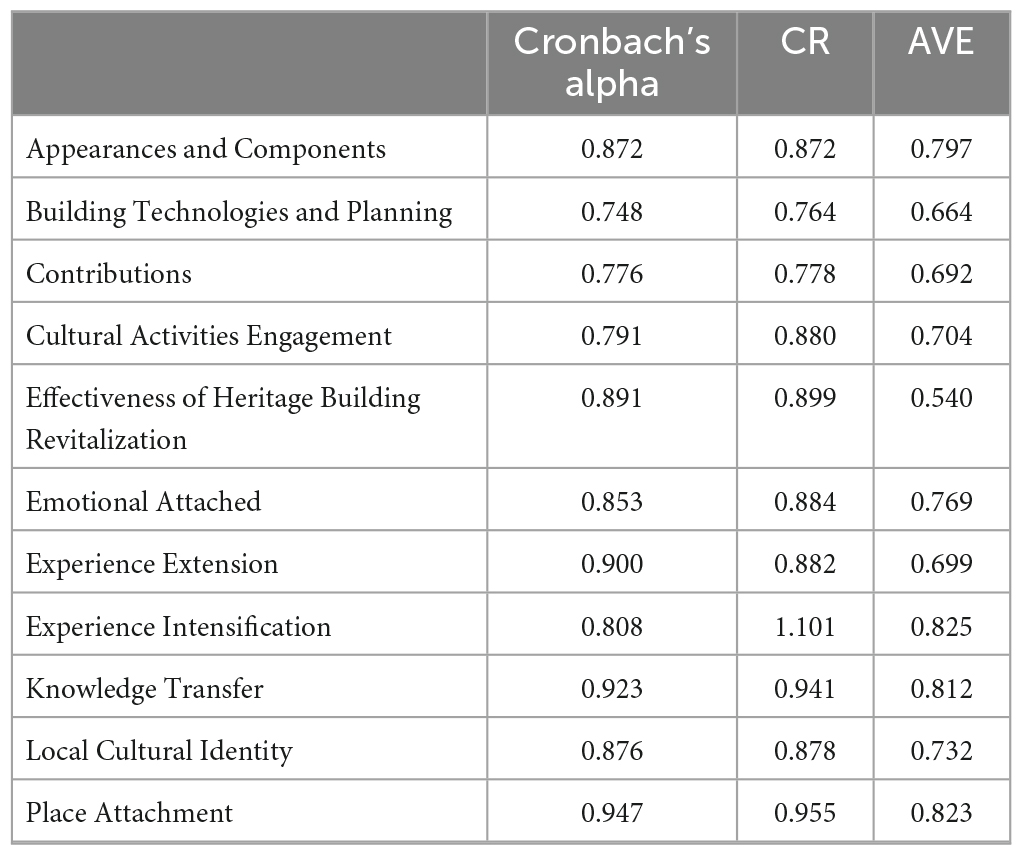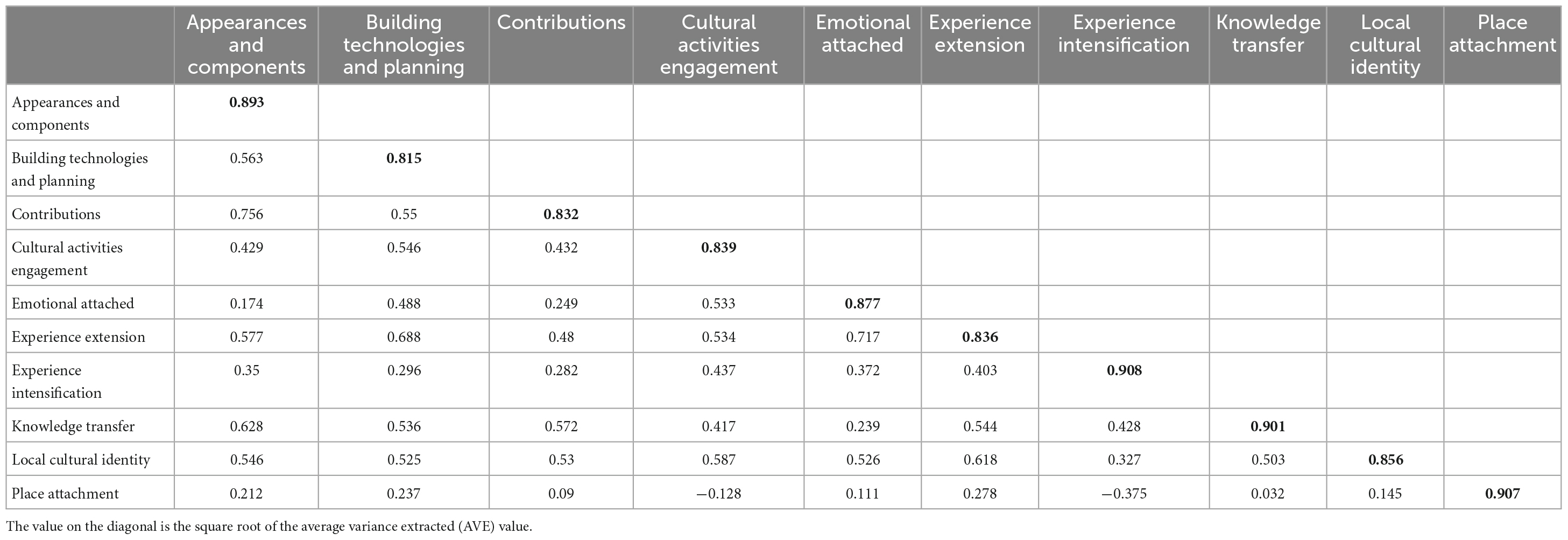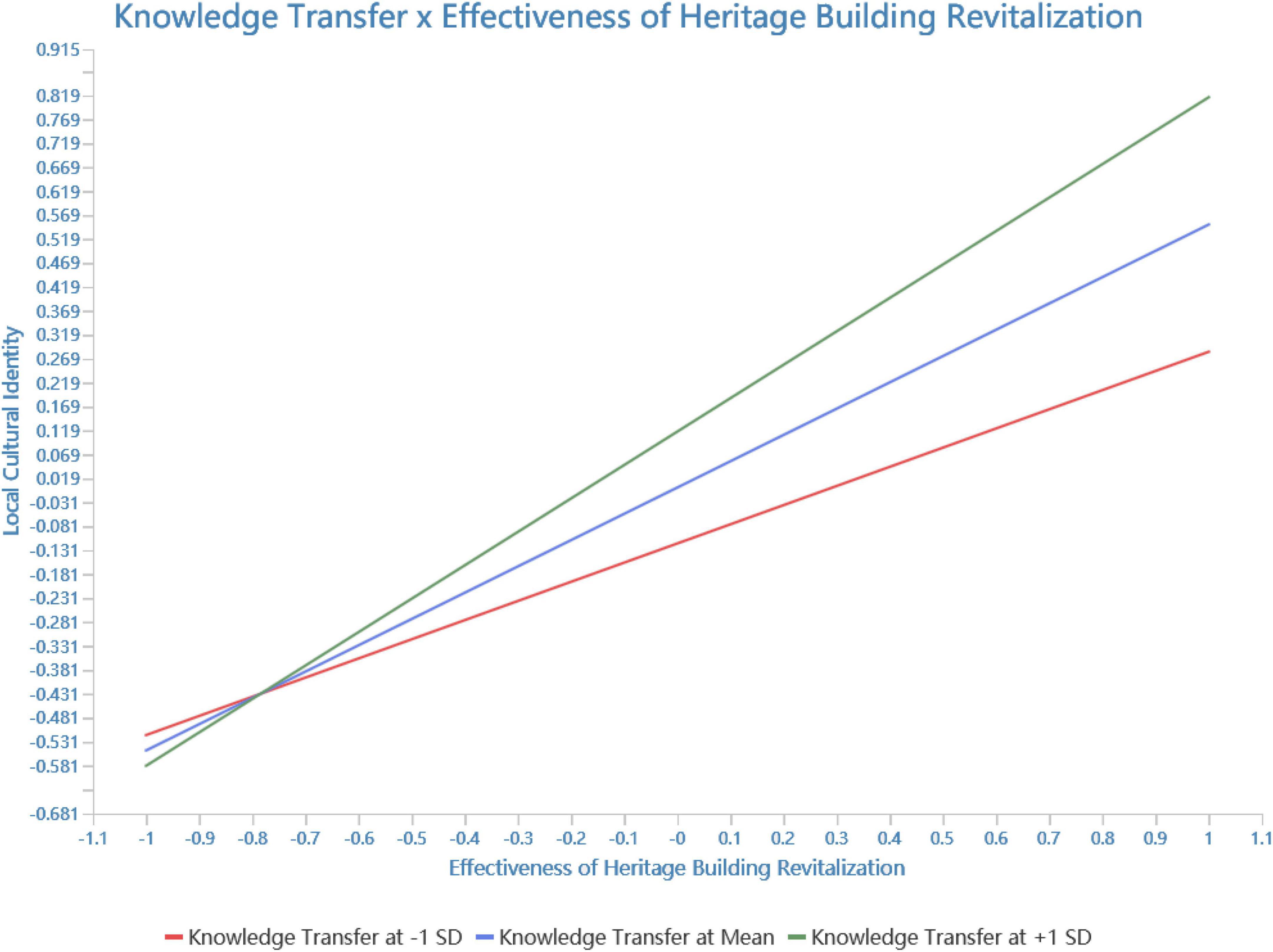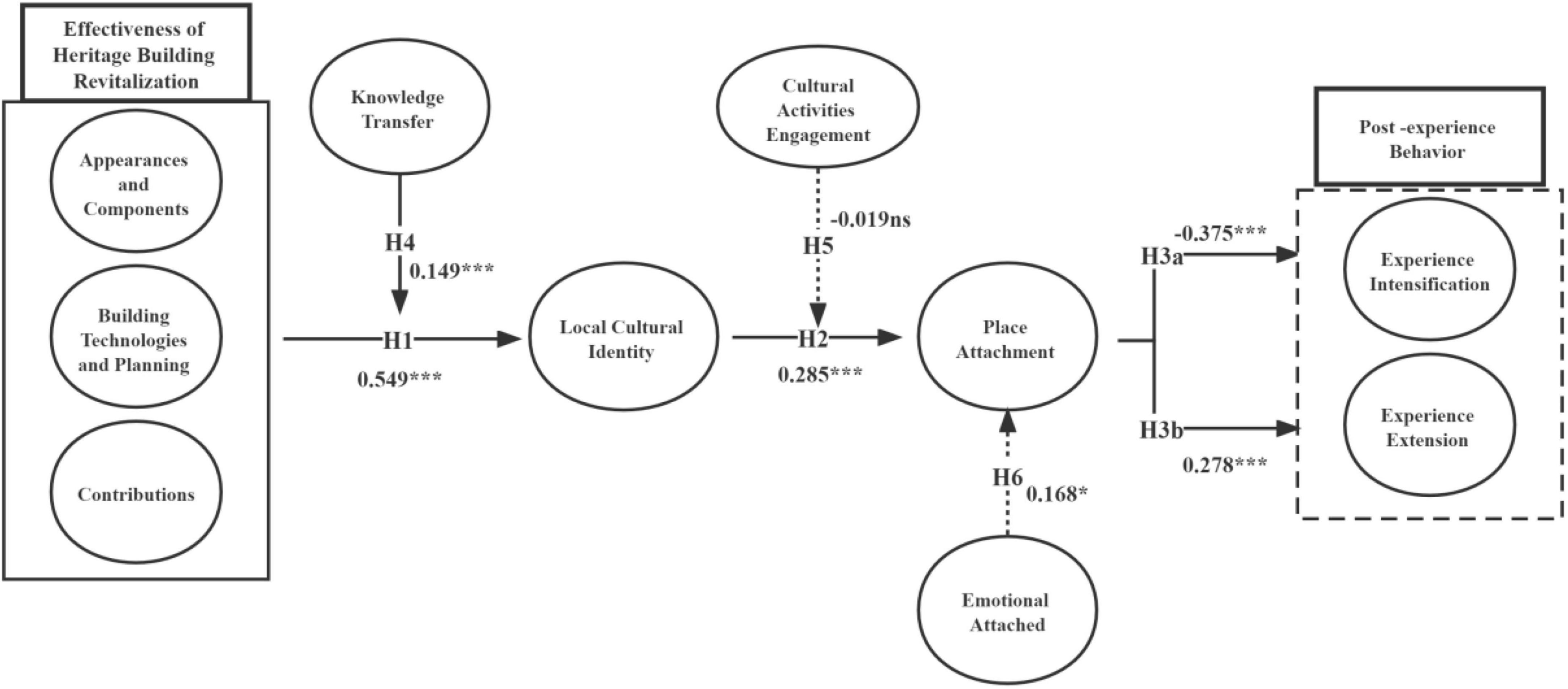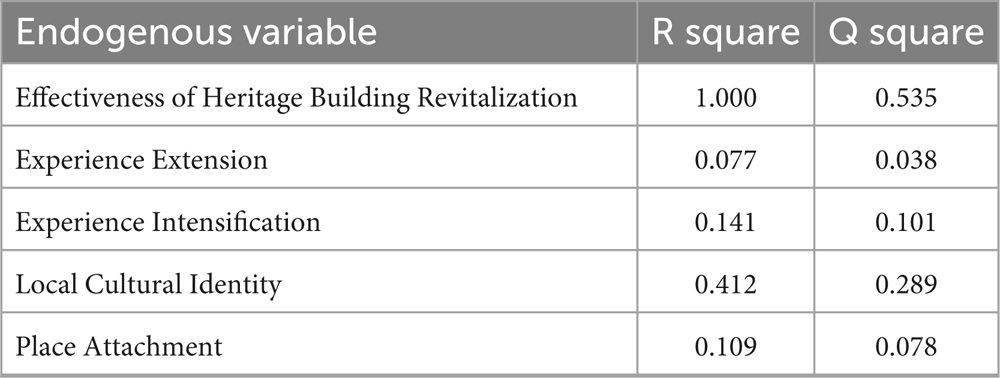- 1School of Liberal Arts, Macau University of Science and Technology, Macau, Macao SAR, China
- 2Institute of Management and Health, University of Wales Trinity Saint David, Swansea, United Kingdom
- 3Faculty of International Tourism and Management, City University of Macau, Macau, Macao SAR, China
- 4Faculty of Innovation and Design, City University of Macau, Macau, Macao SAR, China
Introduction: Cultural heritage buildings are revitalized to promote culture instead of being neglected or demolished. For locals, the revitalization of heritage buildings symbolizes a commitment to the community and a taste of collective memory. The study attempts to test the effectiveness of heritage cultural building on visitors’ post-experience behavior through cultural identity and place attachment. “Cultural activities engagement” and “knowledge transfer” serves as moderating attributes. Their moderating the effects on cultural identity and place attachment are examined, respectively.
Method: A valid sample size of 348 from four heritage buildings located in Hong Kong: Tai Kwun, Police Married Quarters (PMQ), Mei Ho House and The Mills. A data analysis platform for PLSSEM is chosen for this study.
Results: Results demonstrate that the effectiveness of heritage building revitalization on visitors’ local cultural identity and emotions leading to place attachment.
Discussion: In our study, the effectiveness of heritage building encompasses three elements which includes appearance and components; technology and planning as well as contribution. Knowledge transfer positively moderates the effectiveness of heritage building revitalization and cultural identity. However, cultural activity engagement negatively moderates place attachment. Findings also exhibit that place attachment in heritage building revitalization leads to a positive experience extension. For the practical contribution, the study provides insights to policy makers and planners for historic building design such as appearance and components, technology in facilitating local visitors’ local identity.
1 Background
The study scrutinizes the effectiveness of vitalized heritage building on local visitors’ post-experience behavior through local cultural identity and place attachment. The historic buildings selected for the study are located in Hong Kong–Tai Kwun, Police Married Quarters, Mei Ho House and The Mills. The study primarily encompasses three major parts. The first part of the study explores the relationship between the effectiveness of the vitalized heritage buildings and local cultural identity. The second part examines the relationship between the local cultural identity and place attachment. It is posited that cultural activities engagement have a positive impact on place attachment. The last part of the study emphasizes the relationship between the place attachment and local visitors’ post-experience behavior. In this study, the post-experience behavior takes two forms – experience intensification and experience extension. This study examines the moderating effects of knowledge transfer and cultural engagement on visitors’ post-experience behavior. Upon literature review, six hypotheses are developed to frame the study. The study integrates Attachment Theory and Social Identity theory for investigation. For the methodology, the study adopts quantitative approach through survey for data collection. Findings and discussions are laid and the study ends with implications, limitations and future research.
Revitalizing historic buildings aims to maintain a standard that allows visitors to enjoy the cultural resource and create a sense of belonging in the community (Zhang and Smith, 2019; Wang, 2023). The sustainability goals extend beyond protecting the buildings, as they can create value within the local community and influence future behavior (Idrus et al., 2010). Several international examples have proven the value of heritage building revitalization, including Germany’s Zollverein Park, Japan’s Itonowa in the Shimabara district of Kyoto Shiroishi city, Singapore’s ChinaTown and open-air museums in the United Kingdom (Lam et al., 2022). The proven record remarks the success of urban regeneration and the needs for heritage revitalization. More importantly, it serves as benchmarks for rejuvenating heritage buildings and facilitating local visitors’ behavioral intention in Hong Kong.
In Hong Kong there are numerous historical buildings featuring its cultural nostalgia (Chan and Lee, 2017). The project made through the Partnership Scheme (Ho and Hou, 2018) and aims of the project was to conserve the historic building for cultural landmark and to improve the life of near-by residents (Conserve and Revitalise Hong Kong Heritage, 2023). Four buildings in urban areas are involved for revitalization includes Tai Kwun, a central hub for heritage arts (formerly Central Police Station Compound, see Figure 1), PMQ, a creative industries landmark (Central School; formerly Hollywood Road Police Married Quarters, see Figure 2), Mei Ho House, a youth hotel and museum (formerly Public Housing, see Figure 3) and The Mills, a center for heritage and shop floor (formerly Nan Fung Cotton Mills, see Figure 4; Lam et al., 2022). Barber (2020) realized that importance of cultural values of the historic building brought to the community. Liu et al. (2022) highlighted the importance of cultural values brought to the community and facilitated cultural tourism. Besides, limited research on the above four revitalized historic buildings together is found and target local visitors’ for as respondent. In view of the above, the study attempts to fill the above gaps to examine its impact of the four revitalized historic buildings on local visitors’ post-experience behavior.
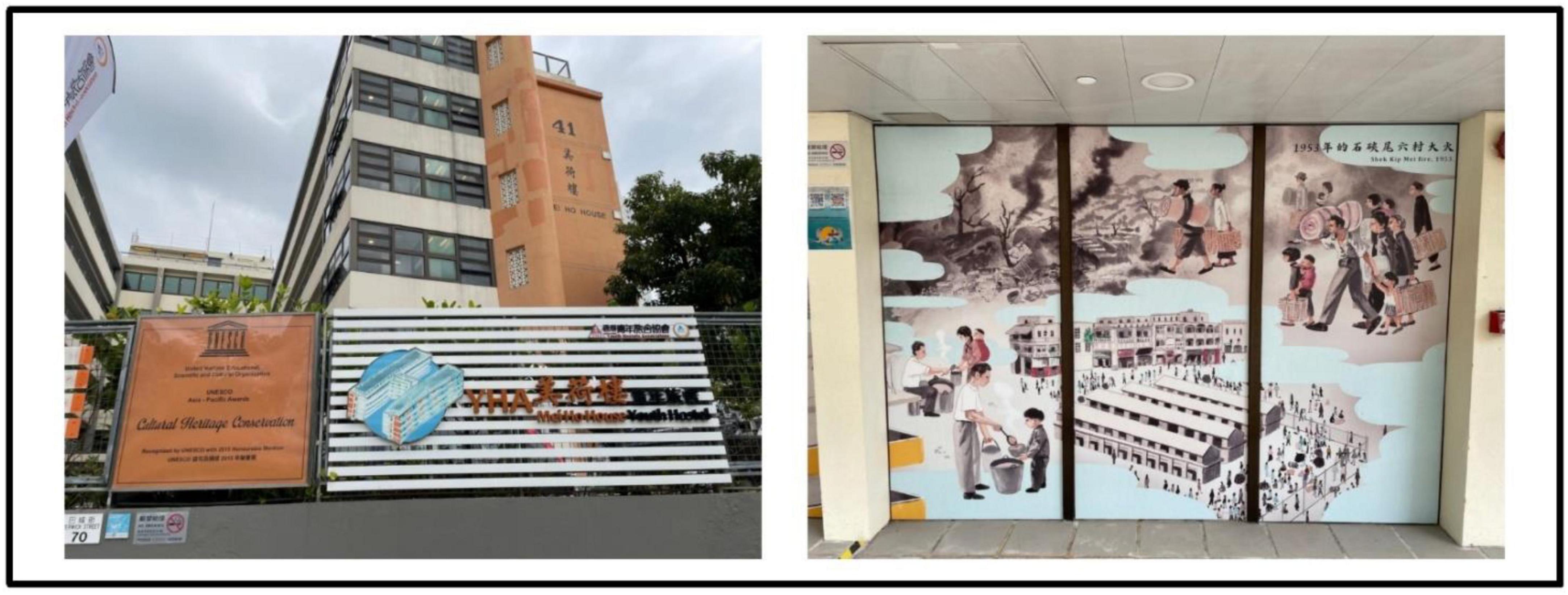
Figure 3. Exterior and Interior from Mei Ho House, a youth hotel and museum. Author’s Self-Photography.
Cultural heritage revitalization such as historic monuments facilitates urban regeneration and bring about socio-economic values to the community and its neighborhood (Douglas, 2005; Ashworth, 2011; Douglas-Jones et al., 2016). However, these positive values are not always explicit to the locals and visitors. Heritage buildings can also contribute to environmental sustainability and education for future generations (Kincaid, 2000; Wilkinson et al., 2009; Spina, 2019; Ali and Qi, 2020). Chan and Lee (2008) highlighted the historical values of heritage based on six benefits, including historical, architectural, group, social and cultural, authenticity and rarity values (Kee, 2019). Additionally, relevant knowledge and engagement in cultural activities can influence visitors’ behavior and their post-experience behavior. Limited studies have focused on the visitors’ viewpoint regarding revitalizing historic buildings and highlight the breadth of perspectives in environment to individuals place attachment and social identity research (Yung and Chan, 2011; Villanueva et al., 2017; Barber, 2020). Implementation of knowledge transfer and cultural activities engagement may play a crucial role in affecting local visitors’ perception of a destination, which has been lacking in previous studies. This work aims to answer the following questions: To what extent does historic building revitalization stimulate local cultural identity? Do local cultural and placement facilitate post-experience behavior?. Do “knowledge transfer” and “cultural activities engagement” moderate local visitors’ post experience behavior? This study incorporates attachment theory and social identity theory as the core of the conceptual models to examine the effectiveness of heritage building revitalization on visitors’ post-experience behavior with knowledge transfer and cultural activities engagement as moderating attributes. The study objectives include:
• to examine the influence of revitalizing heritage buildings on cultural identity
• to investigate the relationship between local cultural identity, place attachment and visitors’ post-experience behavior; and
• to investigate the moderating effect(s) of “knowledge transfer” “cultural activities engagement” on visitors’ post-experience behavior.
This research implies theoretical and practical contributions. For the theoretical contributions, Firstly, it expands the existing literature by exploring the impact of the effectiveness of revitalizing historic buildings on local visitors’ post-experience behavior from visitors’ perspective. Previous studies emphasize the relationship between the historic building and heritage revitalization. To go beyond the scope, the study explores the impact of historic building on post-experience behavior. It helps enhance diversity of research with different spectrums, Secondly, it integrates attachment theory of environmental psychology and social identity theory of social psychology to contextualize the impact of historic building vitalization on local community and visitors’ behavioral intention. Thirdly, it highlights the special values of revitalizing historic buildings for the community and their contribution to sustainable behavior.
For practical contributions, firstly, the study provides insights to destination marketers and planners. Secondly, revitalization of historic building does not only help sustain the cultural heritage, but also facilitates visitors’ attachment to the place. More importantly, the enhanced level of place attachment leads to a positive behavioral intention. The policy makers, destination planner and marketers may reconsider the urban building redesign. Ultimately, the study takes a unique approach by applying these theories to a destination context, providing valuable contributions to academia and practical applications.
2 Literature review
2.1 Attachment theory and social identity theory
In the study of environmental psychology, scholars often adopt attachment theory and place identity concepts in their literature review (Tsai, 2016; Loureiro et al., 2022). Place attachment is used by psychologists to investigate how individuals feel about a particular place. Based on early attachment theory, which highlights a person’s sense of balance between closeness to and distance from key people in their life (Ainsworth, 1967), individuals’ attachment experiences influence their behavior and interactions with others. Place attachment refers to individuals’ emotional ties to their home, communities and societies, particularly their attachment to local environments. The emotional connection individuals feel toward a place may reflect their sense of belonging and connection (Tsai, 2016). Buildings that preserve common memories can become symbols of local cultural identity for residents (Rugwiji, 2019; Cittati et al., 2022). Therefore, revitalized architecture has the potential to reinforce cultural identity differences between local residents and other communities, stimulating the development of local attachments.
The definition of place attachment associate with individuals and their response to place. The psychology of place for individuals which need a positive environment in which to live (Scannell and Gifford, 2017). Others defines the attachment studies which based on person, place and process which affect the individual behaviors (Scannell and Gifford, 2010). Place attachment benefits to individuals’ emotional ties to their home, communities and societies, particularly their attachment to local environments. The emotional connection individuals feel toward a place may reflect their sense of belonging and connection (Tsai, 2016). The attachment common understand “place” as a location object of mental bonds which can provide attributes of physical feature and time where they spent in an environment (Diener and Hagen, 2022). The synergies between place identify for a place sense of place and place identity in provide psychological interaction that occur a crucial aspect to the environment (Scannell and Gifford, 2010). The place belongingness stimulates emotional approach with corned the place “prefer this place” for connection in environment that satisfies individual needs (Tuan, 1974). Furthermore, individuals will take pride to the environments and sense of wellbeing (Scannell and Gifford, 2010), which benefit engagement activities include post-environmental behavior (Anton and Lawrence, 2014; Daryanto and Song, 2021).
Loureiro et al. (2022) emphasize that visitors who engage in outdoor activities enhance pro-environmental behaviors. Promoting education to visitors and protecting heritage buildings can be achieved through outdoor activities. Proshansky (1978) suggests the importance of the physical environment in the development of self-identity. Identity is formed through the relationship individuals establish and the nature of the interactions that take place in a particular environment (Bernardo and Palma-Oliveira, 2012, 2013). The effectiveness of heritage building revitalization strongly reflects local histories and past cultural backgrounds, evoking pleasant memories for local visitors. Therefore, successful heritage building revitalization can create a memorable experience, facilitate a clear understanding of a place and provide educational opportunities for future generations with a focus on sustainability. Revitalized heritage buildings, with effective knowledge transfer to visitors and high engagement in cultural activities, can stimulate emotional ties, enhance visitors’ enjoyment and foster a sense of place attachment. Cultural activities can aid visitors in understanding the history of the heritage building, gaining knowledge and enhancing their collective memory and differentiate themselves from the others. Therefore, culture engagement activities affect their feeling with environmental setting comprised the perception of the environment and provide with their own identity to their place.
Previous study argued that place attachment have a relationship with social identity since the social identification with their place where people think that they can bring the well –being from the environment (Maricchiolo et al., 2021). One of the main reasons is they serves themselves as part of the group or local social group or social identity affect their place attachment. Social identity well defines as people build a perception of themselves by means of abstract social categories and their perceptions become part of people’s self-concepts (Sim et al., 2014; Carter and Bruene, 2019). Social identity influences individuals’ motivation to engage in behaviors that serve the group, as it creates a sense of self-worth and reinforces membership status (Li et al., 2022). However, the inclination of individuals to engage in these behaviors can be amplified by their prosocial motivation. From a motivated information processing perspective, prosocial motivation stimulates the search for information and the processing of group-level attributes that contribute to collective success (Super et al., 2016).
Social identity theory suggests that individuals perceive group members as part of themselves and define themselves as part of a larger whole (Stets and Burke, 2000; Riketta, 2005; Spears, 2011). The theory posits that people categorize the world into “them” and “us,” and they consciously or unconsciously reinforce the differences between groups (Tajfel et al., 1979). As a result, individuals from different cultures have relatively independent notions of social identity. People with similar social identities can cooperate and communicate more effectively because they share attachments to the same group (Smaldino, 2019). Conversely, Scholars (Lewicka, 2011; Ramkissoon et al., 2011) argue that individuals with low identity tend to exhibit low levels of attachment to both groups and places, contributing to their sense of isolation.
Culture is considered a powerful tool for distinguishing groups (Da’as and Zibenberg, 2021). Buildings that preserve common memories can become symbols of local cultural identity for residents. Therefore, revitalized architecture has the potential to reinforce cultural identity differences between local residents and other communities, stimulating the development of local attachments. Buildings that preserve common memories can become symbols of local cultural identity for residents (Rugwiji, 2019; Cittati et al., 2022). Heritage building revitalized has potential to reinforce cultural identity between local residents and other communities, stimulating the development of local attachments. Under this reason, heritage building revitalization provide culture engagement activities can shape individuals behavior.
According to Vaske and Kobrin (2001) identify the relationship between the place attachment and result may lead to sustainable place behavior which lead to environmentally-responsible behavior in other aspect of visitors’ life. Therefore, evoke place attachment can encourage visitors to make protection to a place (Halpenny, 2010). Scholars also confirmed that in addition to the emotional connection, gain knowledge about a place, increases the likelihood that individuals will demonstrate place-protective behaviors (Walker and Chapman, 2003). It is logic to argue local visitors with place attachment to the heritage building revitalization where they are willingness to protect the place since they feel attached. The more willing to protect the heritage building, more willing to attend the culture activities engagement. As result, gain individuals post-experience behavior in this place (Alawadi, 2017; Li et al., 2021). Visitors are more willing to present the experience and sharing to the others (Arnould and Price, 1993). Under the foundation of the place attachment and culture activities engagement, as result they may stimulate the post –experience behavior.
2.2 Linking heritage building revitalization, place attachment and cultural identity
Revitalization entails giving new life, vitality and strength to an area (Lam et al., 2022). The revitalization of heritage buildings can be achieved by either maintaining the building’s original appearance or introducing new elements to meet new requirements (Nowogońska, 2019).
Local cultural identity refers to a sense of belonging to a particular cultural or ethnic group that develops through membership in a specific culture, involving the learning and acceptance of traditional cultural and social structures (Lustig et al., 2006). Cultural identity is regarded as an important perspective for exploring the development mechanism of cultural heritage and as a factor influencing cultural heritage tourism (Wang and Hu, 2014). Individuals with a strong local cultural identity contribute to the protection, development and retention of local areas (Pretty et al., 2003).
According to attachment theory, attachment can be defined as an emotional connection with a person or object that is linked to a person’s sense of security (Chen et al., 2014). Place attachment refers to the positive association or connection between a person and a particular place. Over time, human mental activity, emotional expression and mental health are positively associated with local attachment. A significant manifestation of this association is that individuals feel a sense of closeness to specific places (Aliakbarzadeh Arani et al., 2022).
Building revitalization can improve the efficiency of local resource utilization and reduce pressure on local ecosystems (Andrić et al., 2017). The revitalization of the landmark barn in Mas di Sabe, Italy, has strengthened the cultural identity of the local people and better preserved the collective memory of the area (Cittati et al., 2022). Similarly, the revitalization of heritage buildings in industrial areas in Xi’an, China, demonstrates that buildings once used for industrial purposes can be transformed into liveable and environmentally friendly residences that are popular with locals. These revitalized industrial heritage buildings are expected to foster a strong attachment among younger generations to their hometowns (Li et al., 2015). In a study by Lee and Jeong (2021), satisfactory visitation is noted as an important prerequisite for developing place attachment.
The preservation of historical heritage buildings and the promotion of social connections, place attachment, social cohesion and community identity have significant benefits (Yung and Chan, 2012). Heritage building revitalization provides significant contributions to the local economy and community planning. Overseas examples have demonstrated that after building revitalization, there is an increase in business opportunities for entertainment, attracting non-local visitors who generate economic activities. Value enhancement is not limited to a quantitative economic approach; it also encompasses the connection with local identity. Yung and Chan (2012) argue that local sustainability behavior is influenced by built heritage projects, where locals can enhance their sense of cultural identity through the atmosphere of the place and the quality of the environment. Locals play a crucial role as a motivational force behind the design for the conservation of built heritage, establishing a link to community cultural identity (Tweed and Sutherland, 2007). The revitalization of heritage buildings can increase locals’ pride and understanding of the culture within their community, positively affecting their sense of belonging (Pignataro and Rizzo, 1997).
Study (Halpenny, 2010) confirmed residents have place attachment, they are willing to engage in the local social activities. There is a relationship between place attachment and post –experience behavior. Bricker and Kerstetter (2000) identified that whereas place-dependent recreationists were generally more concerned with resource development and maintenance, recreationists displaying high tendencies toward place identity were more often associated with an interest in resource preservation and maintaining primitive settings. Other studies found a strong positive correlation between rural residents level of support for conservation planning and their level of attachment to the landscape which depends on the different social outdoor activities (Vaske and Kobrin, 2001; Buta et al., 2014). Visitors are more prefer to visit and expand their post-experiences behavior. Therefore, the preservation of historical building can create certain value for local community. The three major elements in evaluating heritage revitalization projects include building appearance and components, planning techniques and public acceptance (Yung and Chan, 2012). Therefore, it is reasonable to argue that the effectiveness of heritage building revitalization can lead to local acceptance and foster post-experience behavior.
2.3 Effectiveness of heritage building revitalization and local cultural identity
Architecture and culture contribute to a sense of place, social traditions and cultural identity spanning centuries of history (Hassler et al., 2002). Although architectural heritage is rarely studied in relation to cultural identity, previous research has highlighted that local residents, tourists, and experts agree that making a region unique with its cultural identity requires a focus on maintaining or even revitalizing heritage buildings. There is a strong link between resident dependence and the renewal of heritage tourism, suggesting that resident dependence increases support for tourism development (Chan and Chen, 2010). Study highlighted in the urban identity which is developed based on five main contexts: geography, function, form, society, and culture (Danilova and Bakshutova, 2020). Local identity can influence citizens’ support for local behaviors, both personally and socially (Belanche et al., 2017). In fact, a culture-led urban renewal that leverages historical assets and local culture is the direction of contemporary urban renewal. Urban residents take pride in their urban identity, attracting tourists from other places who seek to experience and implement the unique characteristics of the destination. Targeted urban renewal driven by a sense of place and cultural identity can be sustainable (Hwang, 2014).
Examples have demonstrated that after building revitalization, there is an increase in business opportunities for entertainment, attracting non-local visitors who generate economic activities (Simard and Mercier, 2001; Elsorady, 2014). Value enhancement is not limited to a quantitative economic approach; it also understands the historical background of the building and encompasses the connection with local identity. The contribution of building of revitalization can create a sense of place which can relate to collective implication. Carr et al. (2016) confirmed the social cohesion, community identity, or affiliation that social groups derive from specific heritage contributes to this value enhancement. Yung and Chan (2012) argue that local sustainability behavior is influenced by built heritage projects, where locals can enhance their sense of cultural identity through the atmosphere of the place and the quality of the environment (Jackson, 2008). Locals play a crucial role as a motivational force behind the design for the conservation of built heritage, establishing a link to community cultural identity (Tweed and Sutherland, 2007).
Based on this, the following hypothesis is proposed:
Hypothesis 1. Heritage building revitalization is positively related to local cultural identity.
2.4 Relationship between cultural identity and place attachment through tourism
Hidalgo and Hernandez (2001) highlight that culture and place identity refers to home, neighborhood and city have positive relationship. The U-shaped relationship between the scale of place and the strength of place attachment may lead visitors to prioritize visiting a city rather than a neighborhood (Bernardo and Palma-Oliveira, 2013). McIlvenny et al. (2009) demonstrate that place attachment and identity play important roles in people’s social and psychological empowerment. They influence each other and jointly determine social and behavioral decisions. Although different cultural backgrounds can create attachment to the same place, multi-racial integration maintains identification within the country (Ujang and Zakariya, 2015). Belanche et al. (2021) which highlighted different approach of place identity is the self that define the individuals identity in relation to the physical environment by means of conscious ideas, belief, preference, feeling, values, goals, and behavioral tendencies and skills relevant to the environment. Individual involves self-awareness of one of the member in their group (Tajfel and Turner, 1979). Therefore, the present group which create self –awareness as a root of culture identity because of psychological to special location or environment, this approach will consider place identity as a feature of the place based on group collective attribution from individual place attachment because of self –identification. Based on this relation, the following hypothesis is proposed:
Hypothesis 2. Local cultural identity is positively related to place attachment.
2.5 Effect of place attachment on visitors’ post-experience behavior
The concept of post-experience behavior was initially proposed by Dong and Siu (2013) to describe the intensification and extension of behavioral tendencies among theme park visitors during and after their play experiences. This concept has also been applied to describe visitors’ behavioral tendencies after nature tourism experiences (Sthapit et al., 2022). Recent research suggests that place attachment is an important prerequisite for the emergence of post-experience behavior (Kim and Lee, 2022).
Post-experience behavior can be divided into two dimensions: experience intensification and experience extension. Experience intensification occurs when visitors who have experienced historic district buildings show a strong willingness to make purchases and feel attached to the place (Alawadi, 2017; Li et al., 2021). Similarly, taking commemorative photographs is a common choice for visitors who have a sense of attachment to the location of historic buildings (Gregory, 2015). These behaviors are examples of experience intensification, as they represent tourists reinforcing their own experiences in the present context.
Experience extension, the other dimension of post-experience behavior, involves sharing the positive aspects of one’s experience with others (Arnould and Price, 1993). Visitors’ intention to revisit a destination is influenced by the meaning locals hold for that destination (Zhang et al., 2018). People with a stronger sense of place attachment are more likely to revisit a particular destination and expand their experiences. Similarly, if a local resident has a strong sense of place attachment, they are more likely to provide information about local excursions when asked (Kim and Lee, 2022). These behaviors are important components of experience extension (Dong and Siu, 2013). Therefore, based on the literature highlighting the impact of place attachment on both dimensions, the following hypotheses are proposed:
Hypothesis 3a. Place attachment is positively related to experience intensification.
Hypothesis 3b. Place attachment is positively related to experience extension.
2.6 Knowledge transfer as a moderator in the relationship between the effectiveness of heritage building revitalization and local cultural identity
Knowledge transfer is defined by Alavi and Leidner (2001) as the process of learning from the knowledge of one organization to another to maintain or gain a competitive advantage. Knowledge transfer can have significant socio-economic impact, particularly on innovation management (Grosse Kathoefer and Leker, 2012). In the context of tourism, effective knowledge transfer can contribute to the competitiveness of tourism destinations and products (Baggioa and Cooperb, 2010). Knowledge transfer is a key element of tourism innovation (Makkonen et al., 2018). It should be maximized to promote tourism development (Werner et al., 2015). Under this logic, knowledge transfer can stimulate the effectiveness of heritage building in revitalization. Facilitating more innovative product for the visitors.
Ashforth (2001) identifies the critical motives in knowledge transfer processes, including the elements of identity, sense-making, self-control and sense of belonging, concluding that such motives stimulate the socialization process. Knowledge transfer can shape individual behavior (Masrek et al., 2011). Kane et al. (2005) highlighted knowledge transfer which have relationship to the group and social identity.
The greater frequency of knowledge transfer in a group which had significant consequences for the performance of those group, the more the understanding toward the identity of the place and physical environment. This helps strengthen individuals’ level of engagement and attachment to the place. Consequently, they are more willing to engage with the social activities and connect to the social and psychical aspects of the place (Seamon, 1979). The engagement of the social and physical environment, social beings never escape their embeddedness (Harvey, 1996). Therefore, under this logic, knowledge transfer may affect culture identity for individuals.
Revitalization of the ancient city of Chiang Mai, for example, has created a cultural identity among locals based on the uniqueness of their city (Phetsuriya and Heath, 2021). Tan and Tan (2020) point out that even locals may not fully realize the uniqueness of their own city and require effective knowledge transfer to gain a deeper understanding. Neglecting or misusing urban heritage can lead to the loss of common urban memory among the younger generation (Cittati et al., 2022). Therefore, the revitalization and proper promotion of heritage buildings can ensure the transfer of common urban memory to the next generation through knowledge, stimulating their sense of cultural identity. Based on this, the following hypothesis is proposed:
Hypothesis 4. Knowledge transfer moderates the effect of heritage building revitalization on local cultural identity, with a stronger effect when knowledge transfer is present.
2.7 Cultural activities engagement as a moderator in the relationship between local cultural identity and place attachment
Activities engagement is defined by Vivek et al. (2014) as the cognitive and emotional absorption that occurs during an activity. Positive emotions are used in a wide range of studies to explain activity engagement (Mageau and Vallerand, 2007). Cultural activities engagement in relationship with local identity and place attachment.
According to social identity theory, individuals are motivated to participate in activities associated with their own group (“us”) rather than activities associated with other groups (“them”) (Tajfel et al., 1979). Attachment theory suggests that people can develop attachments to both individuals and objects (Giuliani, 2003). Therefore, individuals with a strong cultural identity may develop a sense of attachment to a place through cultural activities that reflect their own culture. Schilar and Keskitalo (2018) argue that active engagement in activities is an outward expression of place attachment, even if the cultural identities of those involved in the activities are not homogeneous. On the other hand, a higher level of cultural or ethnic identity is required for the development of place attachment in highly engaged cultural activities. For example, Turkish immigrants living in Germany reinforce their cultural identity differences from the locals through cultural activities in mosques. These highly engaged cultural activities strengthen Turkish cultural identity and attachment to their homeland (Ehrkamp, 2005; Demmrich and Arakon, 2021). Research by Freeman et al. (2022) suggests that cultural background identity strongly influences cultural activities engagement and place attachment.
Hypothesis 5. Cultural activities engagement moderates the effect of local cultural identity on place attachment in that the effect is stronger for cultural activities engagement.
2.8 Effect of emotional attachment on place attachment
Emotional attachment is defined as an emotionally charged connection between a person and a particular object (Thomson et al., 2005). A stronger attachment to a specific target induces an emotionally charged state of mental readiness that influences the individual’s emotions, cognition and behavior toward the object (Hang et al., 2020). When emotional attachment becomes strong, it manifests as external expressions related to love and passion (Ladhari et al., 2020). Initially, emotional attachment was thought to be associated with negative emotions, but research also suggests the involvement of positive emotions in the construction of emotional attachment (Goodall, 2015). Furthermore, Hosany et al. (2017) found that both positive and negative affect are important antecedents of place attachment, as evidenced by proximity-seeking behavior, separation pain, feelings of security provided by attachment objects and mourning for loss (Sperling and Berman, 1994).
Trauer and Ryan (2005) argue that place attachment and emotional attachment are strongly related. Place memory and place expectancy are considered important predictors of place attachment by Chen et al. (2014), and place expectancy and emotional attachment influence each other. Bora and Voiculescu (2021) suggest that the more negative a person’s memory of a place is, the more challenging it becomes for emotional attachment to develop, resulting in weaker attachment to that place. Loureiro (2014) argues that positive emotions lead to stronger place attachment.
Hypothesis 6. Emotional attachment is positively related to place attachment.
Therefore, the following conceptual model as shown in Figure 5 is proposed.
3 Methodology
3.1 Methods selection
The nature of the research determines the methodology (Lee et al., 2016). In order to explore the relationship between the models in the conceptual model, qualitative research is not appropriate. Instead, Structural Equation Modeling (SEM) in quantitative research is suitable for exposing the complex relationships between the constructs in the above model (Mikulić and Ryan, 2018). In addition, for the measurement of the constructs, the questionnaire method is currently widely adopted. By filling out the questionnaire, the respondents’ mental state can be fully recorded by the data (Mikulić and Ryan, 2018). Therefore, collecting data through questionnaire method and modeling the data within the framework of SEM was selected as the methodological framework for this study. Because of the second-order modeling involved in this study, as well as the fact that this paper was conducted in an exploratory research framework. Therefore covariance-based structural equation modeling (CB-SEM) and partial least squares structural equation modeling (PLS-SEM), the latter was selected as the data processing method for this study (Dash and Paul, 2021).
3.2 Measurement
The measurement items used in this study were derived from well-established scales in the historical literature. The measurement of Effectiveness of Heritage Building Revitalization referred to the scale of Chang et al. (2020), which consists of 3 dimensions: Appearances and Components, Building Technologies and Planning and Contributions. The measurement of Local Cultural Identity is based on the scale of Zeng and Xu (2021), and the measurement of Knowledge Transfer is based on the scale of Liu (2018). Cultural Activities Engagement refers to the scale of Peng et al. (2023). Place Attachment refers to the scale of Von Wirth et al. (2016). Emotional Attached refers to the scale of Kowalczyk and Pounders (2016). Post Experience Behavior was divided into two dimensions, Experience Intensification and Experience Extension. These two dimensions were measured with reference to the scales of Dong and Siu (2013) and Kim and Lee (2022). Therefore, a total of 44 questions were included in this study to measure all constructs. The specific construct measurement items and their sources were presented in Table 1.
The questionnaire was prepared in both English and Chinese as it was distributed in Hong Kong. Back-translation was adopted to enhance the survey’s credibility (Ozolins et al., 2020). The study aimed to examine the psychological behavior of visitors toward revitalized historic buildings, so the authors sought assistance from three industry experts in the field of heritage building revitalization and tourism. After their translation and double-checking, the final version of the questionnaire was prepared.
The researcher conducted a pre-test of the questionnaire on a 50-person size at the target sampling site prior to the formal distribution of the questionnaire (Perneger et al., 2015). The purpose to enhance the readability and reliability of the questionnaire. According to the principle of deleting questions with factor loading below 0.7, we deleted questions that could not explain the concepts adequately. In this way, the questionnaire was purified. Finally, AC4, AC5, and AC6 in Appearances and Components were deleted, and BTP1 in Building Technologies and Planning was deleted. CAE1 and CAE3 in Cultural Activities Engagement were deleted. EI3 in Experience Intensification and EE3 in Experience Extension were deleted. The final questionnaire therefore had a cumulative total of 35 questions on the construct measure.
3.3 City selection and sample collection
Owing to the distinctive achievements of Hong Kong in historic building revitalization, this study focused on collecting samples from the most popular locations in Hong Kong.
The questionnaire consisted of three parts. The first part comprised a screening question to confirm whether the respondents were visitors who had visited Tai Kwun, Police Married Quarters, Mei Ho House, or The Mills. These four buildings are highly popular in Hong Kong and serve as the source buildings for the development of the effectiveness scale of heritage building revitalization (Lam et al., 2022). The second part consisted of 44 questions on ten research model constructs. Respondents were asked to recall their psychological feelings during their visit to the aforementioned revitalized buildings and indicate their level of agreement on a Likert scale. A response of “1” indicated strong disagreement, whereas “7” indicated strong agreement. To mitigate the possibility of common method bias, the constructs in the questionnaire were presented in a random order rather than following the consistent arrangement of Table 1. Additionally, the five measurement items of Place Attachment were presented using negative questioning instead of the original positive questioning format (Chang et al., 2020). The final part of the questionnaire involved collecting personal information.
The questionnaire was distributed among local people, through the researchers’ personal connections and on-site distribution at the exits of the four revitalized architectural sites (Tai Kwun, Police Married Quarters, Mei Ho House, or The Mills).
The reason why we selected the four sites in Hong Kong since the cities develops rapidly, local government allowed a rich and distinct culture to evolve which can reflect by the architecture. Many old buildings found in Hong Kong which provide a strong culture characteristic (Lam et al., 2022). Furthermore, the flagship heritage building in Hong Kong with economic value to the local community. The selection of Tai Kwun, Police Married Quarters, Mei Ho House and Mills since they are holding a high level of symbolic important includes for historical, political and economic centrality (Barber, 2020). We decided to collect data from those places since we can verify the right respondents and the result can create credibility.
To ensure the sampled subjects were representative of the overall visitor sample, the field questionnaire recovery time spanned weekdays and weekends. Only seven out of 359 respondents indicated that they had not visited the revitalized buildings mentioned above, even though they were local Hong Kong residents. Therefore, the final number of valid questionnaires was 348.
3.4 Data analysis method
Several analysis methods exist for examining psychological latent variables. However, given that the theoretical model in this paper incorporates mediating and moderating variables, as well as multiple dependent variables, structural equation modeling (SEM) is deemed more suitable for uncovering the relationships between the respective variables (Duncan, 2014). There are several platforms for running the PLS-SEM algorithm, but the most widely accepted is smartPLS (Dash and Paul, 2021). Thus, the data analysis platform selected for this study is PLS-SEM using smartPLS 4.0.9.2.
4 Findings
4.1 Demographic information
Table 2 presents the demographic information of the respondents who completed the valid questionnaire. The gender distribution was predominantly female (60.06%). The age range with the highest number of respondents was 18–24 years old, and as age increased, the number of respondents decreased. The proportion of respondents with and without a local place of birth was similar. Lastly, the largest occupation group among the respondents was students (55.17%), followed by enterprise employees (31.03%).
4.2 Construct reliability and validity
Table 3 displays the mean, standard deviation and factor loading of the measurement items for all constructs. According to Hair et al. (2019), items with factor loadings below 0.7 should be removed. Therefore, not all 44 questions were used in the final analysis, and a total of nine items were removed. Additionally, the higher-order construct Effectiveness of Heritage Building Revitalization was measured using the repeated indicator method. To ensure consistency in the interpretation of lower-order constructs, one additional question (AC5) was removed, resulting in a consistent number of questions across the three dimensions.
Table 4 presents the Cronbach’s alpha values, composite reliability (CR) and average variance extracted (AVE) for each construct. Based on Hair et al. (2019), values above 0.7 for Cronbach’s alpha and CR, as well as AVE values above 0.5, demonstrate the reliability and convergent validity of the data. It is worth noting that Experience Intensification’s composite reliability (rho_a) exceeds 1. This is not an unusual result, but there is no literature yet highlighting that this value exceeds 1 as a sign of serious problems with the data. Therefore, the authors believe that this value does not yet validate that there is a problem with composite reliability.
Table 5 shows the results of the discriminant validity test. Following the criteria of Fornell and Larcker (1981) and Ab Hamid et al. (2017), as the square root of AVE is greater than the correlation coefficient between the corresponding constructs, all constructs in this study are independent of one another, indicating sufficient discriminant validity for the model.
4.3 Results of PLS analysis
4.3.1 Direct effect analysis
According to Hair et al. (2012), a total of 352 valid samples and 5000 subsamples were analyzed to assess the significance of the paths.
Table 6 displays the analysis of the direct effects between the constructs. Appearances and Components, Building Technologies and Planning and Contributions are all found to be valid indicators of Effectiveness of Heritage Building Revitalization, confirming the findings of Lam et al. (2022). Furthermore, Appearances and Components (βAppearances and Components – > Effectiveness of Heritage Building Revitalization = 0.450, p < 0.001) and Contributions (βContributions –> Effectiveness of Heritage Building Revitalization = 0.325, p < 0.001) are explored that contribute most to Effectiveness of Heritage Building Revitalization, rather than Building Technologies and Planning (βBuilding Technologies and Planning – > Effectiveness of Heritage Building Revitalization = 0.374, p < 0.001).
H1 and H2 are supported because Effectiveness of Heritage Building Revitalization is shown to have a positive effect on Local Cultural Identity (βEffectiveness of Heritage Building Revitalization – > Local Cultural Identity = 0.549, p < 0.001). In addition, Local Cultural Identity promotes Place Attachment (βLocal Cultural Identity – > Place Attachment = 0.285, p < 0.001).
Interestingly, the results indicate that Place Attachment has a negative effect on Experience Intensification (βPlace Attachment – > Experience Intensification = −0.375, p < 0.001) and positive effect on Experience Extension (βPlace Attachment – > Experience Extension = 0.278, p < 0.001). Ding and Hung (2021) suggest that Experience Extension is associated with individuals’ willingness to recommend, so people with a high level of Place Attachment readily mention the positive aspects of the building to others. However, local visitors are already familiar with the historical background of these buildings and may not make frequent visits. Therefore, Place Attachment is negatively related to Experience Intensification, whereas Experience Extension demonstrates a positive approach. Consequently, H3a is rejected, but H3b is supported. The moderating effect hypotheses, H4 and H5, will be further discussed in the next section.
H6 is also supported because Emotional Attached to revitalization by locals significantly leads to Place Attachment (β Emotional Attached – > Place Attachment = 0.168, p < 0.05).
4.3.2 Indirect effect analysis
The results presented in Table 7 represent the analysis of the mediating effects. Consistent with the previous discussion, Effectiveness of Heritage Building Revitalization positively influences residents’ Experience Extension and negatively influences Experience Intensification through mediating variables.
The results of the test for moderating effect are presented in Table 8. The moderating effect of Knowledge Transfer is demonstrated (β = 0.149, 95% CI = [0.070, 0.223]). This implies that the positive effect of Heritage Building Revitalization on Local Cultural Identity is enhanced with the enhancement of Knowledge Transfer. Hence, H4 is supported. This result aligns with Cheung and Chan (2014), suggesting that managers of as all sized buildings can consider strengthening the construction of guided tours, which, in turn, will enhance Knowledge Transfer. Figure 6 presents a simple slope analysis of Effectiveness of Heritage Building Revitalization moderated by Knowledge Transfer. The effect of the interaction term on local cultural identity significantly differs when adding the mean or subtracting one standard deviation.
However, the moderating effect of Cultural Activities Engagement is not demonstrated in the relationship between Local Cultural Identity and Place Attachment (β = −0.019, 95% CI = [0.134, 0.104]). This result indicates that H5 is rejected. Thus, the effect of Local Cultural Identity may not be affected by cultural activities engagement as a moderator in relation to Place Attachment. Figure 7 represents the final test result of the conceptual model.
Table 9 presents the R square and Q square values of all dependent variables for both models. Following the criteria of Cohen (1988) and Rehman Khan and Yu (2021), as all R square values exceed the minimum threshold of 0.02 and all Q square values are greater than 0, the variance of the exogenous variable in the model can well explain the variance of the endogenous variable. Additionally, the predictive relevance of the model is deemed satisfactory.
5 Conclusion
Findings confirms the positive impact of heritage building revitalization on visitors’ post experience behavior. Firstly, results confirm that heritage building revitalization positively supports local visitors’ cultural identity and place attachment. The effectiveness of heritage building revitalization lies on appearances and components, technology as well as planning and contributions. Findings postulated that all these three elements are positively related to visitors’ cultural identity and emotion. These help facilitate place attachment (Morgan, 2010; Hosany et al., 2017).
Secondly, place attachment is negatively related to experience intensification. Conversely, place attachment is positively related to experience extension. Findings confirmed that emotional attachment influence the level of place attachment. Emotional attachment also demonstrates a positive relationship with place attachment. The findings are somewhat consistent with the literature findings Positive emotions in tourism favor a valence-based approach (Russell, 1980) and research has shown that positive emotions toward a place reinforce a sense of attachment (Morgan, 2010).
Thirdly, knowledge transfer is positively related to heritage building revitalization. It can be explained by the fact that knowledge transfer facilitates visitors’ understanding about the building such as building’s history and other factual information. This help evokes a sense of intense vicariousness and lead to place attachment. The finding is consistent with the previous literature findings that heritage buildings hold a strong position in educating visitors and creating a sense of place (Hou and Wu, 2020).
Lastly, cultural activities engagement is negatively related to the relationship between local cultural identity and place attachment. This implies that cultural activities engagement does not enhance the effect of local cultural identity on place attachment (Rajadurai et al., 2023). It can be explained by the fact that local visitors, who are already familiar with the historical buildings and the community, may not engage in purchase behavior on-site. Nor do they make efforts to make their experience a tangible one.
5.1 Implications of the study
From a managerial perspective, positive results of heritage building revitalization provide insights for destination marketers. The appearance components, technologies and planning and contributions contribute to the identification and self-belongingness of the place. Developers involved in the planning of heritage building revitalization need to consider the benefits not only limited to the building itself and the surrounding environment but also the marketing of conservation strategies and the facilitation of service provision and delivery.
By showcasing tangible historic buildings whilst providing value to locals and fulfilling the role of cultural inheritance, marketers can adopt knowledge transfer to enhance visitors’ positive psychological wellbeing. Knowledge transfer delivers additional information to visitors, helping them better understand the history or background of the place. Marketers can craft stories and deliver messages through heritage building revitalization, enabling visitors to comprehend the importance of long-term building preservation for sustainability.
Additionally, the findings indicate that emotional attachment leads to satisfaction and cultural identity. Positive emotions resulting from service encounters and cultural experiences may lead to positive word-of-mouth recommendations. Place attachment creates memories that reinforce visitor emotions associated with a place (Grisaffe and Nguyen, 2011). Destination management should aim to evoke positive emotions and foster place attachment through knowledge transfer to visitors.
Furthermore, increasing place identity can be achieved by providing more cultural explanations or activities. Adopting more technologies to enhance the visitor experience can improve their intention to revisit.
From an academic perspective, study expands upon existing research by addressing the viewpoint of visitors and measuring post-experience behavior related to heritage building revitalization. It establishes the roles of heritage building revitalization and initiates a conceptual framework for further evaluation. The integration of social identity theory and attachment theory in a cross-disciplinary manner highlights the importance of heritage building revitalization in relation to visitors’ cultural identity and place attachment, rather than solely focusing on urban development and planning. Future studies can explore visitors’ psychological perspectives to better understand their post-experience behavior.
5.2 Limitations and future study
The findings of this study are subject to certain limitations. Firstly, the sampling was limited to local visitors, and the results may differ for overseas visitors. Local visitors, being familiar with the background of the heritage buildings, may have different perspectives compared within international visitors when visiting these heritage sites. Secondly, the city selection was limited to Hong Kong’s heritage buildings, and different results may be obtained in cross-pacific countries due to different policies, planning and management as well as varying rules and regulations.
From a destination management perspective, future studies can examine the frequency of visits to these attractions by distinguishing between first-time visitors and repeat visitors. Capturing visitors’ pre- and post-visiting experiences to heritage buildings can provide further insights into their visiting intentions. To minimize bias, a mixed methods approach can be adopted, combining qualitative and quantitative research methods to gain a comprehensive understanding of visitors’ needs and expectations regarding the services provided by heritage buildings.
Data availability statement
The raw data supporting the conclusions of this article will be made available by the authors, without undue reservation.
Ethics statement
Ethical review and approval was not required for the study on human participants in accordance with the local legislation and institutional requirements. Written informed consent from the patients/participants or patients/participants legal guardian/next of kin was not required to participate in this study in accordance with the national legislation and the institutional requirements.
Author contributions
SC: Writing—original draft, Writing—review and editing. WL: Writing—original draft, Writing—review and editing. BT: Data curation, Methodology, Writing—original draft, Writing—review and editing. ZC: Writing—original draft.
Funding
The author(s) declare that no financial support was received for the research, authorship, and/or publication of this article.
Conflict of interest
The authors declare that the research was conducted in the absence of any commercial or financial relationships that could be construed as a potential conflict of interest.
Publisher’s note
All claims expressed in this article are solely those of the authors and do not necessarily represent those of their affiliated organizations, or those of the publisher, the editors and the reviewers. Any product that may be evaluated in this article, or claim that may be made by its manufacturer, is not guaranteed or endorsed by the publisher.
References
Ab Hamid, M., Sami, W., and Sidek, M. M. (2017). Discriminant validity assessment: use of Fornell and Larcker criterion versus HTMT criterion. J. Phys. Conf. Ser. 890:012163. doi: 10.1088/1742-6596/890/1/012163
Ainsworth, M. D. (1967). Infancy in Uganda. Infant Care and the Growth of Love. Oxford: Johns Hopkins Press.
Alavi, M., and Leidner, D. E. (2001). Knowledge management and knowledge management systems: conceptual foundations and research issues. MIS Q. 25, 107–136. doi: 10.2307/3250961
Alawadi, K. (2017). Place attachment as a motivation for community preservation: the demise of an old, bustling. Dubai community. Urban Stud. 54, 2973–2997. doi: 10.1177/0042098016664690
Ali, N., and Qi, Z. (2020). Historical study and strategies for revitalisation of burt institute (a railway heritage building). Historic Environ. Policy Pract. 11, 40–55. doi: 10.1080/17567505.2019.1599611
Aliakbarzadeh Arani, Z., Zanjari, N., Delbari, A., Foroughan, M., and GhaedaminiHarouni, G. (2022). Place attachment and aging: a scoping review. J. Hum. Behav. Soc. Environ. 32, 91–108. doi: 10.1080/10911359.2020.1860852
Andrić, I., Pina, A., Ferrão, P., Lacarrière, B., and Le Corre, O. (2017). The impact of renovation measures on building environmental performance: an emergy approach. J. Cleaner Production 162, 776–790. doi: 10.1016/j.jclepro.2017.06.053
Anton, C. E., and Lawrence, C. (2014). Home is where the heart is: the effect of place of residence on place attachment and community participation. J. Environ. Psychol. 40, 451–461. doi: 10.1016/j.jenvp.2014.10.007
Arnould, E. J., and Price, L. L. (1993). River magic: extraordinary experience and the extended service encounter. J. Consum. Res. 20, 24–45. doi: 10.1086/209331
Ashforth, B. E. (2001). Role Transitions in Organisational Life: an Identity-Based Perspective. Hillsdale, NJ: Lawrence Erlbaum Associate. doi: 10.4324/9781410600035
Ashworth, G. (2011). Preservation, conservation and heritage: approaches to the past in the present through the built environment. Asian Anthropol. 10, 1–18. doi: 10.1080/1683478X.2011.10552601
Baggioa, R., and Cooperb, C. (2010). Knowledge transfer in a tourism destination: the effects of a network structure. Serv. Industries J. 30, 1757–1771. doi: 10.1080/02642060903580649
Barber, L. B. (2020). Capitalizing on culture in flagship heritage initiatives: transforming Hong Kong’s police married quarters into “PMQ”. City Cult. Soc. 21, 100275. doi: 10.1016/j.ccs.2018.09.002
Belanche, D., Casaló, L. V., and Flavián, C. (2017). Understanding the cognitive, affective and evaluative components of social urban identity: determinants, measurement, and practical consequences. J. Environ. Psychol. 50, 138–153. doi: 10.1016/j.jenvp.2017.02.004
Belanche, D., Casaló, L. V., and Rubio, M. A. (2021). Local place identity: a comparison between residents of rural and urban communities. J. Rural Stud. 83, 242–252. doi: 10.1016/j.jrurstud.2021.01.003
Bernardo, F., and Palma-Oliveira, J. (2013). Place identity, place attachment and the scale of place: the impact of place salience. Psyecology 4, 167–193. doi: 10.1080/21711976.2013.10773867
Bernardo, F. Palma-Oliveira, J. M. (2012). Place identity: A central concept in understanding intergroup relationships in the urban context,” in The role of place identity in the perception, understanding, and design of built environments, eds H. Casakin and Bernardo, F. (Danvers, MA: Bentham), 35–46.
Bora, I., and Voiculescu, M. (2021). Resettlement, intergenerational memory, place attachment, and place identity in Roşia Jiu coal mine-Gorj county. Romania. J. Rural Stud. 86, 578–586. doi: 10.1016/j.jrurstud.2021.07.008
Bricker, K., and Kerstetter, D. (2000). Level of specialization and place attachment an exploratory study of whitewater recreation. Leisure Sci. 22, 233–257. doi: 10.1080/01490409950202285
Buta, N., Holland, S. M., and Kaplanidou, K. (2014). Local communities and protected areas: the mediating role of place attachment for pro-environmental civic engagement. J. Outdoor Recreation Tour. 5- 6, 1–10. doi: 10.1016/j.jort.2014.01.001
Carr, A., Ruhanen, L., and Whitford, M. (2016). Indigenous peoples and tourism: the challenges and opportunities for sustainable tourism. J. Sustainable Tour. 24, 1067–1079. doi: 10.1080/09669582.2016.1206112
Carter, M. J., and Bruene, S. (2019). Examining the relationship between self-perceptions of person, role, and social identity change and self-concept clarity. Imagination Cogn. Pers. 38, 425–451. doi: 10.1177/0276236618792267
Chan, E., and Lee, G. K. (2008). Critical factors for improving social sustainability of urban renewal projects. Soc. Ind. Res. 85, 243–256. doi: 10.1007/s11205-007-9089-3
Chan, Y. W., and Lee, V. P. (2017). Postcolonial cultural governance: a study of heritage management in post-1997 Hong Kong. Int. J. Heritage Stud. 23, 275–287. doi: 10.1080/13527258.2016.1269238
Chang, S.-J., Van Witteloostuijn, A., and Eden, L. (2020). Common method variance in international business research. Res. Methods Int. Bus. 41, 385–398. doi: 10.1007/978-3-030-22113-3_20
Chen, C. -F., and Chen, P. -C. (2010). Resident attitudes toward heritage tourism development. Tour. Geogr. 12, 525–545.
Chen, N., Dwyer, L., and Firth, T. (2014). Conceptualization and measurement of the dimensionality of place attachment. Tour. Anal. 13, 323–338. doi: 10.3727/108354214X14029467968529
Cheung, E., and Chan, A. P. (2014). Revitalizing historic buildings through a partnership scheme: innovative form of social public–private partnership. J. Urban Planning Dev. 140:04013005. doi: 10.1061/(ASCE)UP.1943-5444.0000161
Cittati, V.-M., Balest, J., and Exner, D. (2022). What is the relationship between collective memory and the commoning process in historical building renovation projects? the case of the mas di sabe, Northern Italy. Sustainability 14:11870. doi: 10.3390/su141911870
Cohen, J. (1988). Statistical Power Analysis for the Behavior Sciences, 2nd Edn. New York: Routledge Academic.
Conserve and Revitalise Hong Kong Heritage (2023). Revitalisation Scheme About the Scheme. Availabe online at https://www.heritage.gov.hk/en/revitalisation-scheme/batch-vi-of-revitalisation-scheme/about-the-scheme/index.html (accessed 11 December 2023)
Da’as, R. A., and Zibenberg, A. (2021). Conflict, control and culture: implications for implicit followership and leadership theories. Educ. Rev. 73, 194–208. doi: 10.1080/00131911.2019.1601614
Danilova, E. V., and Bakshutova, D. V. (2020). Model of urban identity of a Russian city through the example of Samara. IOP Conf. Ser. Mater. Sci. Eng. 775:012010. doi: 10.1088/1757-899X/775/1/012010
Daryanto, A., and Song, Z. (2021). A meta-analysis of the relationship between place attachment and pro-environmental behavior. J. Bus. Res. 123, 208–219. doi: 10.1016/j.jbusres.2020.09.045
Dash, G., and Paul, J. (2021). CB-SEM vs PLS-SEM methods for research in social sciences and technology forecasting. Technol. Forecasting Soc. Change 173:121092. doi: 10.1016/j.techfore.2021.121092
Demmrich, S., and Arakon, M. (2021). Kurdish, Turkish, German? identificative integration of Kurds in Germany. Ethnic Racial Stud. 44, 659–678. doi: 10.1080/01419870.2020.1752391
Diener, A., and Hagen, J. (2022). Geographies of place attachment: a placed based model of materiality, performance and narration. Geogr. Rev. 112, 171–186. doi: 10.1080/00167428.2020.1839899
Ding, H.-M., and Hung, K.-P. (2021). The antecedents of visitors’ flow experience and its influence on memory and behavioral intentions in the music festival context. J. Destination Marketing Manag. 19:100551. doi: 10.1016/j.jdmm.2020.100551
Dong, P., and Siu, N. Y.-M. (2013). Servicescape elements, customer predispositions and service experience: the case of theme park visitors. Tour. Manag. 36, 541–551. doi: 10.1016/j.tourman.2012.09.004
Douglas, M. (2005). “A feeling for hierarchy,” in Believing Scholars, ed. J. L. Heft (New York: Fordham University Press). doi: 10.5422/fso/9780823225255.003.0008
Douglas-Jones, R., Hughes, J. J., Jones, S., and Yarrow, T. (2016). Science, value and material decay in the conservation of historic environments. J. Cult. Heritage 21, 823–833. doi: 10.1016/j.culher.2016.03.007
Ehrkamp, P. (2005). Placing identities: transnational practices and local attachments of Turkish immigrants in Germany. J. Ethn. Migr. Stud. 31, 345–364. doi: 10.1080/1369183042000339963
Elsorady, D. A. (2014). Assessment of the compatibility of new uses for heritage buildings: the example of Alexandria National Museum. Alexandria, Egypt. J. Cult. Heritage 15, 511–521. doi: 10.1016/j.culher.2013.10.011
Fornell, C., and Larcker, D. F. (1981). Structural Equation Models with Unobservable Variables and Measurement Error: Algebra and Statistics. Los Angeles, CA: Sage. doi: 10.2307/3150980
Freeman, C., LataiNiusulu, A., Schaaf, M., Taua’a, T. S., Tanielu, H., Ergler, C., et al. (2022). Identity, belonging and place attachment amongst Pacific Island children: a photographic analysis. Children’s Geogr. 21, 271–286. doi: 10.1080/14733285.2022.2039900
Giuliani, M. V. (2003). “Theory of attachment and place attachment,” in Psychological Theories for Environmental Issues, eds M. Bonnes, T. Lee, and M. Bonaiuto (Hampshire: Aldershot).
Goodall, K. (2015). Individual differences in the regulation of positive emotion: the role of attachment and self esteem. Pers. Individ. Dif. 74, 208–213. doi: 10.1016/j.paid.2014.10.033
Gregory, J. (2015). Connecting with the past through social media: the ‘Beautiful buildings and cool places Perth has lost’Facebook group. Int. J. Heritage Stud. 21, 22–45. doi: 10.1080/13527258.2014.884015
Grisaffe, D. B., and Nguyen, H. P. (2011). Antecedents of emotional attachment to brands. J. Bus. Res. 64, 1052–1059. doi: 10.1016/j.jbusres.2010.11.002
Grosse Kathoefer, D., and Leker, J. (2012). Knowledge transfer in academia: an exploratory study on the not-invented-here syndrome. J. Technol. Transfer 37, 658–675. doi: 10.1007/s10961-010-9204-5
Hair, J. F., Risher, J. J., Sarstedt, M., and Ringle, C. M. (2019). When to use and how to report the results of PLS-SEM. Eur. Bus. Rev. 31, 2–24. doi: 10.1108/EBR-11-2018-0203
Hair, J. F., Sarstedt, M., Ringle, C. M., and Mena, J. A. (2012). An assessment of the use of partial least squares structural equation modeling in marketing research. J. Acad. Mark. Sci. 40, 414–433. doi: 10.1007/s11747-011-0261-6
Halpenny, E. A. (2010). Pro-environmental behaviours and park visitors: the effect of place attachment. J. Environ. Psychol. 30, 409–421. doi: 10.1016/j.jenvp.2010.04.006
Hang, H., Aroean, L., and Chen, Z. (2020). Building emotional attachment during COVID-19. Ann. Tour. Res. 83:103006. doi: 10.1016/j.annals.2020.103006
Hassler, U., Algreen-Ussing, G., and Kohler, N. (2002). Cultural heritage and sustainable development in SUIT. SUIT Position Paper 3, 1–5.
Hidalgo, M. C., and Hernandez, B. (2001). Place attachment: conceptual and empirical questions. J. Environ. Psychol. 21, 273–281. doi: 10.1006/jevp.2001.0221
Ho, D., and Hou, H. Y. (2018). Enabling sustainable built heritage revitalisation from a social and technical perspective: a case study. Facilities 37, 704–722. doi: 10.1108/F-05-2017-0055
Hosany, S., Prayag, G., Van Der Veen, R., Huang, S., and Deesilatham, S. (2017). Mediating effects of place attachment and satisfaction on the relationship between tourists’ emotions and intention to recommend. J. Travel Res. 56, 1079–1093. doi: 10.1177/0047287516678088
Hou, H., and Wu, H. (2020). A case study of facilities management for heritage building revitalisation. Facilities 38, 201–217. doi: 10.1108/F-02-2019-0020
Hwang, K. H. (2014). Finding Urban identity through culture-led Urban regeneration. J. Urban Manag. 3, 67–85. doi: 10.1016/S2226-5856(18)30084-0
Idrus, A., Khamidi, F., and Sodangi, M. (2010). Maintenance management framework for conservation of heritage buildings in Malaysia. Modern Appl. Sci. 4, 66–77. doi: 10.5539/mas.v4n11p66
Jackson, A. (2008). Local and regional history as heritage: The heritage process and conceptualising the purpose and practice of local historians. Int. J. Heritage Stud. 14, 362–379. doi: 10.1080/13527250802155877
Kane, A., Argote, L., and Levine, J. (2005). Knowledge transfer between groups via personnel rotation: effects of social identity and knowledge quality. Organ. Behav. Hum. Decision Processes 96, 56–71. doi: 10.1016/j.obhdp.2004.09.002
Kee, T. (2019). Sustainable adaptive reuse–economic impact of cultural heritage. J. Cult. Heritage Manag. Sustainable Dev. 9, 165–183. doi: 10.1108/JCHMSD-06-2018-0044
Kim, M., and Lee, G. (2022). The effect of servicescape on place attachment and experience evaluation: the importance of exoticism and authenticity in an ethnic restaurant. Int. J. Contemp. Hospitality Manag. 34, 2664–2683. doi: 10.1108/IJCHM-07-2021-0929
Kincaid, D. (2000). Adaptability potentials for buildings and infrastructure in sustainable cities. Facilities 18, 155–161. doi: 10.1108/02632770010315724
Kowalczyk, C. M., and Pounders, K. R. (2016). Transforming celebrities through social media: the role of authenticity and emotional attachment. J. Product Brand Manag. 25, 345–356. doi: 10.1108/JPBM-09-2015-0969
Ladhari, R., Massa, E., and Skandrani, H. (2020). YouTube vloggers’ popularity and influence: the roles of homophily, emotional attachment, and expertise. J. Retail. Consumer Serv. 54:102027. doi: 10.1016/j.jretconser.2019.102027
Lam, E. W., Zhang, F., and Ho, J. K. (2022). Effectiveness and advancements of heritage revitalizations on community planning: case studies in Hong Kong. Buildings 12:1065. doi: 10.3390/buildings12081065
Lee, V. H., Foo, A. T. L., Leong, L. Y., and Ooi, K. B. (2016). Can competitive advantage be achieved through knowledge management? A case study on SMEs. Expert Syst. Appl. 65, 136–151. doi: 10.1016/j.eswa.2016.08.042
Lee, W., and Jeong, C. (2021). Distinctive roles of tourist eudaimonic and hedonic experiences on satisfaction and place attachment: combined use of SEM and necessary condition analysis. J. Hosp. Tour. Manag. 47, 58–71. doi: 10.1016/j.jhtm.2021.02.012
Lewicka, M. (2011). Place attachment: how far have we come in the last 40 years? J. Environ. Psychol. 31, 207–230. doi: 10.1016/j.jenvp.2010.10.001
Li, J., Irina, Y. Y., Yang, M. X., and Chen, S. (2022). How needs for belongingness and justice influence social identity and performances: evidence from the hospitality industry. J. Hosp. Tour. Manag. 50, 366–374. doi: 10.1016/j.jhtm.2022.02.015
Li, L., Shen, Y., and Meng, X. (2015). “Research on the innovation model of the old industrial building renovation under the concept of Ecology——Xi’an–a case study of 1935 Dahua,” in Proceedings of the 2015 International Forum on Energy, Environment Science and Materials. (Amsterdam: Atlantis Press).
Li, Z., Shu, S., Shao, J., Booth, E., and Morrison, A. M. (2021). Innovative or not? the effects of consumer perceived value on purchase intentions for the palace museum’s cultural and creative products. Sustainability 13:2412. doi: 10.3390/su13042412
Liu, C.-H. S. (2018). Examining social capital, organizational learning and knowledge transfer in cultural and creative industries of practice. Tour. Manag. 64, 258–270. doi: 10.1016/j.tourman.2017.09.001
Liu, P., An, X., and Li, X. (2022). You are an outsider! how and when observed leader incivility affect hospitality employees’ social categorization and deviant behavior. Int. J. Hosp. Manag. 106:103273. doi: 10.1016/j.ijhm.2022.103273
Loureiro, S. M. C. (2014). The role of the rural tourism experience economy in place attachment and behavioral intentions. Int. J. Hosp. Manag. 40, 1–9. doi: 10.1016/j.ijhm.2014.02.010
Loureiro, S. M. C., Guerreiro, J., and Han, H. (2022). Past, present, and future of pro-environmental behavior in tourism and hospitality: a text-mining approach. J. Sustainable Tour. 30, 258–278. doi: 10.1080/09669582.2021.1875477
Lustig, M. W., Koester, J., and Halualani, R. (2006). Intercultural competence: Interpersonal communication across cultures. Boston, MA: Pearson/A and B Boston.
Mageau, G. A., and Vallerand, R. J. (2007). The moderating effect of passion on the relation between activity engagement and positive affect. Motiv. Emot. 31, 312–321. doi: 10.1007/s11031-007-9071-z
Makkonen, T., Williams, A. M., Weidenfeld, A., and Kaisto, V. (2018). Cross-border knowledge transfer and innovation in the European neighbourhood: tourism cooperation at the Finnish-Russian border. Tour. Manag. 68, 140–151. doi: 10.1016/j.tourman.2018.03.008
Maricchiolo, F., Mosca, O., Paolini, D., and Fornara, F. (2021). The mediating role of place attachment dimension in the relationship between local identity and well-being. Environ. Psychol. 12:645648. doi: 10.3389/fpsyg.2021.645648
Masrek, M. N., Noordin, S. A., Anwar, N., and Idris, A. S. A. (2011). The relationship between cultural identity and individual knowledge sharing behavior. IBIMA Bus. Rev. 2011:14. doi: 10.5171/2011.406402
McIlvenny, P., Broth, M., and Haddington, P. (2009). Communicating place, space and mobility. J. Pragmatics 10, 1879–1886. doi: 10.1016/j.pragma.2008.09.014
Mikulić, J., and Ryan, C. (2018). Reflective versus formative confusion in SEM based tourism research: a critical comment. Tour. Manag. 68, 465–469. doi: 10.1016/j.tourman.2018.05.002
Morgan, P. (2010). Towards a developmental theory of place attachment. J. Environ. Psychol. 30, 11–22. doi: 10.1016/j.jenvp.2009.07.001
Nowogońska, B. (2019). Performance characteristics of buildings in the assessment of revitalization needs. Civil Environ. Eng. Rep. 29, 119–127. doi: 10.2478/ceer-2019-0009
Ozolins, U., Hale, S., Cheng, X., Hyatt, A., and Schofield, P. (2020). Translation and back-translation methodology in health research–a critique. Exp. Rev. Pharmacoecon. Outcomes Res. 20, 69–77. doi: 10.1080/14737167.2020.1734453
Peng, J., Yang, X., Fu, S., and Huan, T.-C. T. (2023). Exploring the influence of tourists’ happiness on revisit intention in the context of traditional Chinese Medicine cultural tourism. Tour. Manag. 94:104647. doi: 10.1016/j.tourman.2022.104647
Perneger, T. V., Courvoisier, D. S., Hudelson, P. M., and Gayet-Ageron, A. (2015). Sample size for pre-tests of questionnaires. Qual. Life Res. 24, 147–151. doi: 10.1007/s11136-014-0752-2
Phetsuriya, N., and Heath, T. (2021). Defining the distinctiveness of urban heritage identity: Chiang Mai old city, Thailand. Soc. Sci. 10:101. doi: 10.3390/socsci10030101
Pignataro, G., and Rizzo, I. (1997). “The Political economy of rehabilitation: the case of the Benedetti monastery, economic perspectives on cultural heritage, Palgrave,” in Palgrave Macmillan Books, eds M. Hutter and I. Rizzo (London: Palgrave Macmillan). doi: 10.1007/978-1-349-25824-6_6
Pretty, G. H., Chipuer, H. M., and Bramston, P. (2003). Sense of place amongst adolescents and adults in two rural Australian towns: the discriminating features of place attachment, sense of community and place dependence in relation to place identity. J. Environ. Psychol. 23, 273–287. doi: 10.1016/S0272-4944(02)00079-8
Proshansky, H. M. (1978). The city and self-identity. Environ. Behav. 10, 147–169. doi: 10.1177/0013916578102002
Rajadurai, S. V., and Geetha, V. (2023). “A response to John Harriss,” in Decentring the Indian Nation (London: Routledge), 118–124.
Ramkissoon, H., Weiler, B., and Smith, L. D. G. (2011). Place attachment and pro-environmental behavior in national parks: the development of a conceptual framework. J. Sustainable Tour. 20, 257–276. doi: 10.1080/09669582.2011.602194
Rehman Khan, S. A., and Yu, Z. (2021). Assessing the eco-environmental performance: an PLS-SEM approach with practice-based view. Int. J. Logistics Res. Appl. 24, 303–321. doi: 10.1080/13675567.2020.1754773
Riketta, M. (2005). Organizational identification: a meta-analysis. J. Vocat. Behav. 66, 358–384. doi: 10.1016/j.jvb.2004.05.005
Rugwiji, T. T. (2019). Identity reconstruction of the great zimbabwe national monument: an indigenous knowledge systems perspective. StudiaHistoriaeEcclesiasticae 45, 1–18. doi: 10.25159/2412-4265/4145
Russell, J. A. (1980). A circumplex model of affect. J. Pers. Soc. Psychol. 39:1161. doi: 10.1037/h0077714
Scannell, L., and Gifford, R. (2010). Defining place attachment: a tripartite organizing framework. J. Environ. Psychol. 30, 1–10. doi: 10.1016/j.jenvp.2009.09.006
Scannell, L., and Gifford, R. (2017). The experienced psychological benefits of place attachment, J. Environ. Psychol. 51, 256–269. doi: 10.1016/j.jenvp.2017.04.001
Schilar, H., and Keskitalo, E. C. H. (2018). Tourism activity as an expression of place attachment–place perceptions among tourism actors in the Jukkasjärvi area of northern Sweden. Scand. J. Hosp. Tour. 18, S42–S59. doi: 10.1080/15022250.2017.1389123
Sim, J., Goyle, A., Mckedy, W., Eidelman, S., and Correll, J. (2014). How social identity shapes the working self-concept. J. Exp. Soc. Psychol. 55, 271–277. doi: 10.1016/j.jesp.2014.07.015
Simard, M., and Mercier, G. (2001). Planning, participation and identity in quebec city: community building through Urban revitalization. Can. J. Urgan Res. 10, 23–26.
Smaldino, P. E. (2019). Social identity and cooperation in cultural evolution. Behav. Processes 161, 108–116. doi: 10.1016/j.beproc.2017.11.015
Spears, R. (2011). “Group identities: the social identity perspectives,” in Handbook Identity Theory and Research, eds K. Luyckx, V. L. Vignoles, and S. Schwartz (Berlin: Springer). doi: 10.1007/978-1-4419-7988-9_9
Sperling, M. B., and Berman, W. H. (1994). Attachment in Adults: Clinical and Developmental Perspectives. New York, NY: Guilford Press.
Spina, D. L. (2019). Multidimensional assessment for “culture-led” and “community-driven” urban regeneration as driver for trigger economic vitality in urban historic centers. Sustainability 11:7237. doi: 10.3390/su11247237
Stets, J. E., and Burke, P. (2000). Identity theory and social identity. Soc. Psychol. Quart. 63, 224–237. doi: 10.2307/2695870
Sthapit, E., Björk, P., and Coudounaris, D. N. (2022). Memorable nature-based tourism experience, place attachment and tourists’ environmentally responsible behaviour. J. Ecotourism 22, 542–565. doi: 10.1080/14724049.2022.2091581
Super, J. F., Li, P., Ishqaidef, G., and Guthrie, J. P. (2016). Group rewards, group composition and information sharing: a motivated information processing perspective. Organ. Behav. Hum. Decis. Processes 134, 31–44. doi: 10.1016/j.obhdp.2016.04.002
Tajfel, H., and Turner, J. C. (1979). An integrative theory of intergroup conflict,” in Organizational identity: A reader, eds W. G. Austin and Worchel, S. (Oxford: Oxford University Press), 56–65.
Tajfel, H., Turner, J. C., Austin, W. G., and Worchel, S. (1979). “An integrative theory of intergroup conflict,” in Intergroup Relations: Essential Readings, eds M. A. Hogg and D. Abrams (London: Psychology Press).
Tan, S.-K., and Tan, S.-H. (2020). Clan/geographical association heritage as a place-based approach for nurturing the sense of place for locals at a World Heritage Site. J. Hosp. Tour. Manag. 45, 592–603. doi: 10.1016/j.jhtm.2020.10.017
Thomson, M., MacInnis, D. J., and Whan Park, C. (2005). The ties that bind: measuring the strength of consumers’ emotional attachments to brands. J. Consum. Psychol. 15, 77–91. doi: 10.1207/s15327663jcp1501_10
Trauer, B., and Ryan, C. (2005). Destination image, romance and place experience—an application of intimacy theory in tourism. Tour. Manag. 26, 481–491. doi: 10.1016/j.tourman.2004.02.014
Tsai, C. T. (2016). Memorable tourist experiences and place attachment when consuming local food. Int. J. Tour. Res. 18, 536–548. doi: 10.1002/jtr.2070
Tuan, Y.-F. (1974). Review of mental maps., by P. Gould and R. White. Ann. Assoc. Am. Geogr. 64, 589–591.
Tweed, C., and Sutherland, M. (2007). Built cultural heritage and sustainable urban development. Landscape Urban Planning 83, 62–69. doi: 10.1016/j.landurbplan.2007.05.008
Ujang, N., and Zakariya, K. (2015). The notion of place, place meaning and identity in urban regeneration. Proc. Soc. Behav. Sci. 170, 709–717. doi: 10.1016/j.sbspro.2015.01.073
Vaske, J. J., and Kobrin, K. C. (2001). Place attachment and environmentally responsible behavior. J. Environ. Educ. 32, 16–21. doi: 10.1080/00958960109598658
Villanueva, G., Gonzalez, C., Son, M., Moreno, E., Lin, W., and Ball-Rokeach, S. (2017). Bringing local voices into community revitalization :engaged communication research in Urban planning. J. Appl. Commun. Res. 45, 479–494. doi: 10.1080/00909882.2017.1382711
Vivek, S. D., Beatty, S. E., Dalela, V., and Morgan, R. M. (2014). A generalized multidimensional scale for measuring customer engagement. J. Mark. Theory Pract. 22, 401–420. doi: 10.2753/MTP1069-6679220404
Von Wirth, T., Grêt-Regamey, A., Moser, C., and Stauffacher, M. (2016). Exploring the influence of perceived urban change on residents’ place attachment. J. Environ. Psychol. 46, 67–82. doi: 10.1016/j.jenvp.2016.03.001
Walker, G. J., and Chapman, R. (2003). Thinking like a park: the effects of sense of place, perspective-taking, and empathy on pro-environment intentions. J. Park Recreation Adm. 21, 71–86.
Wang, Y. (2023). Exploring multiple dimensions of attachment to historic urban places, a case study of Edinburgh, Scotland. Int. J. Heritage Stud. 29, 428–440. doi: 10.1080/13527258.2023.2193817
Wang, Y., and Hu, H. (2014). Cultural identity: the core mechanism for the survival and development of intangible cultural heritage. Fujian Trib 10, 49–55.
Werner, K., Dickson, G., and Hyde, K. F. (2015). Learning and knowledge transfer processes in a mega-events context: the case of the 2011 Rugby World Cup. Tour. Manag. 48, 174–187. doi: 10.1016/j.tourman.2014.11.003
Wilkinson, S. J., James, K., and Reed, R. (2009). Using building adaptation to deliver sustainability in Australia. Struct. Survey 27, 46–61. doi: 10.1108/02630800910941683
Yung, E. H. K., and Chan, E. H. W. (2011). Problem issues of public participation in built-heritage conservation: Two controversial cases in Hong Kong. Habitat Int. 35, 457–466.
Yung, E. H., and Chan, E. H. (2012). Implementation challenges to the adaptive reuse of heritage buildings: towards the goals of sustainable, low carbon cities. Habitat Int. 36, 352–361. doi: 10.1016/j.habitatint.2011.11.001
Zeng, Y., and Xu, R. (2021). An exploration of the relationships between nostalgia, involvement, and behavioral intention in diaspora tourism. Sustainability 13:12273. doi: 10.3390/su132112273
Zhang, H., Wu, Y., and Buhalis, D. (2018). A model of perceived image, memorable tourism experiences and revisit intention. J. Destination Mark. Manag. 8, 326–336. doi: 10.1016/j.jdmm.2017.06.004
Keywords: cultural identity, heritage building, place attachment, post-experience behavior, revitalization
Citation: Chan SHG, Lee WHH, Tang BM and Chen Z (2024) Legacy of culture heritage building revitalization: place attachment and culture identity. Front. Psychol. 14:1314223. doi: 10.3389/fpsyg.2023.1314223
Received: 16 October 2023; Accepted: 26 December 2023;
Published: 23 January 2024.
Edited by:
Myriam Ertz, Université du Québec à Chicoutimi, CanadaReviewed by:
Pinghao Ye, Wuhan Business University, ChinaChourouk Ouerghemmi, Tunis El Manar University, Tunisia
Copyright © 2024 Chan, Lee, Tang and Chen. This is an open-access article distributed under the terms of the Creative Commons Attribution License (CC BY). The use, distribution or reproduction in other forums is permitted, provided the original author(s) and the copyright owner(s) are credited and that the original publication in this journal is cited, in accordance with accepted academic practice. No use, distribution or reproduction is permitted which does not comply with these terms.
*Correspondence: Binglin Martin Tang, VDIyMDkyMTEwMDU3QGNpdHl1Lm1v
 Suk Ha Grace Chan
Suk Ha Grace Chan Wing Han Helen Lee
Wing Han Helen Lee Binglin Martin Tang
Binglin Martin Tang Ziyi Chen4
Ziyi Chen4